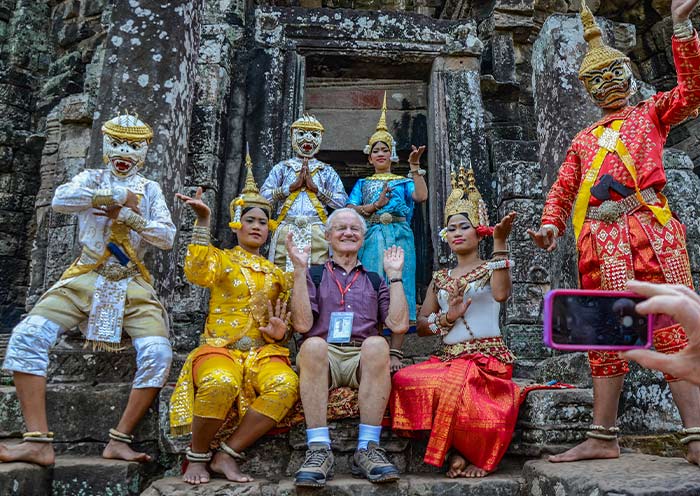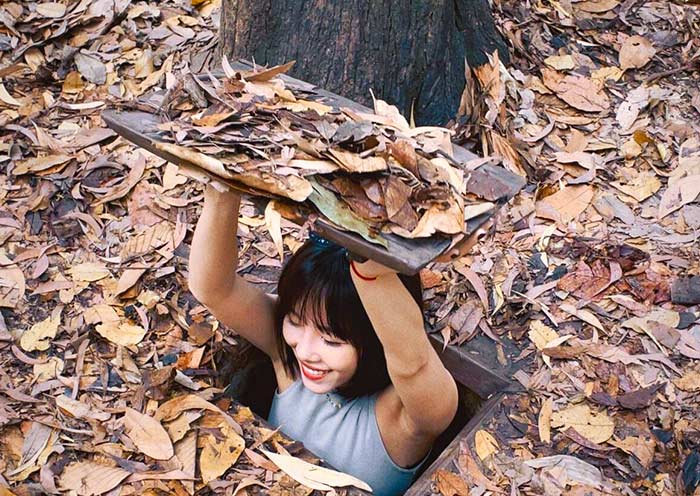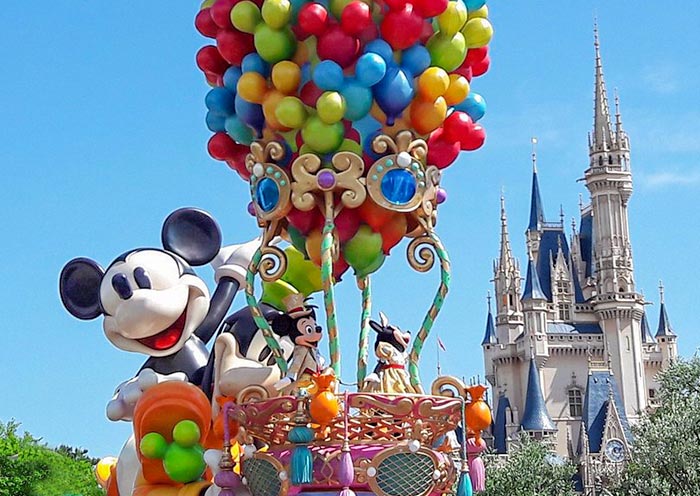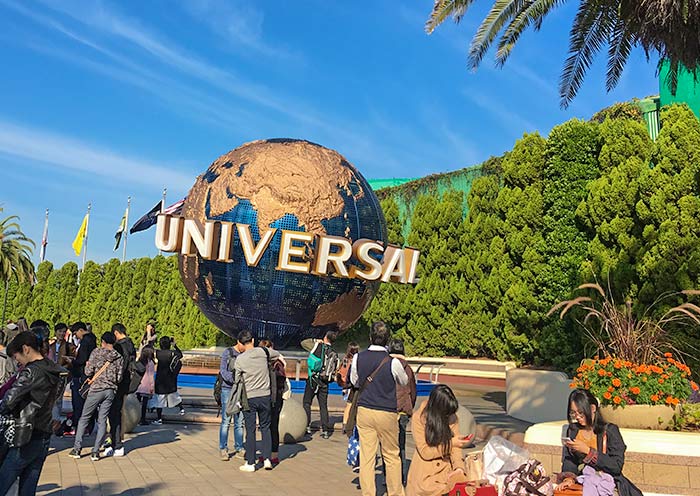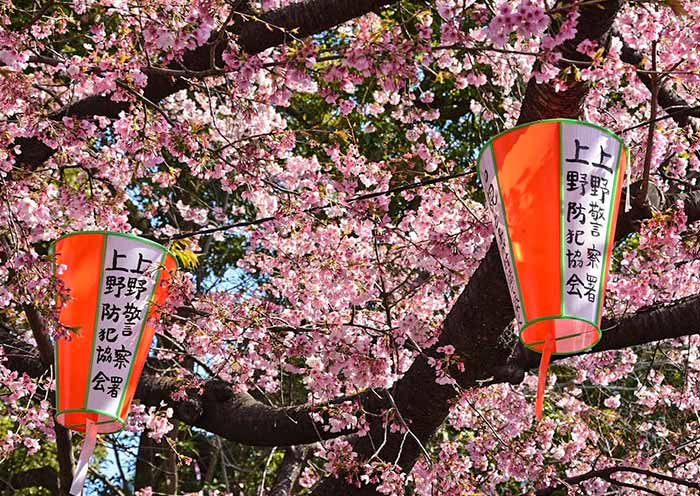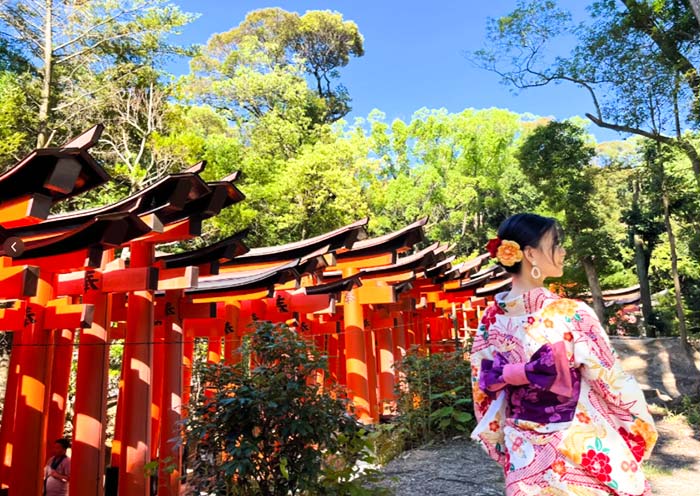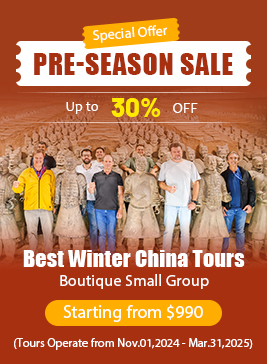Our 8 days group tour in December was amazing! Tokyo’s vibrant streets and Mount Fuji’s snow-capped beauty were breathtaking. Kyoto’s temples and Nara’s deer park offered a serene charm, while Osaka dazzled with its food and nightlife. Hiroshima’s Peace Memorial Park was deeply moving. The crisp winter atmosphere and festive illuminations added a magical touch. Traveling with a small group made the experience fun, seamless, and unforgettable!
21 Days Japan Thailand Cambodia Vietnam Tour Package - Best of Four Asia Countries
- Highlights
- Itinerary
- Price
- Trip Notes
- Accommodation
- Photos
- Reviews
Best Asia Tour to Tokyo, Kyoto, Osaka, Bangkok, Pattaya, Siem Reap, Saigon & Hanoi
First-time to visit Asia? Have 3 Weeks of Vacation and wish to explore the most popular sights in Asia? Take our 21 Days Japan Thailand Cambodia Vietnam Tour Package - Enjoy the Best of Four Asia Countries in one trip. Your Best Asia Tour to Tokyo, Kyoto, Osaka, Bangkok, Pattaya, Siem Reap, Saigon & Hanoi will covers the Top Tourist Destinations in East Asia (Japan) & Southeast Asia (Thailand Cambodia Vietnam), offering a diverse Asian experience.
During the first week Tour in Japan (East Asia), visit Tokyo, Mt. Fuji, Kyoto, Nara & Osaka, indulging in a Japan Culture Tour featuring 6 World Heritage Sites & a Glimpse of Buddhism & Shinto. This Classic Japan Tour delves into the heart of Japan, a land where ancient traditions harmonize with modern marvels.
The following two-week Tour in Southeast Asia provides a taste of Thailand, Cambodia, and Vietnam, offering a broad view of the region's cultural and geographic diversity. Explore iconic sights like Bangkok's Grand Palace, Pattaya Beach, Angkor Wat, the Mekong Delta, and Halong Bay.
Contact us for your 21 Days Japan Thailand Cambodia Vietnam Tour Package, covering Tokyo, Kyoto, Osaka, Bangkok, Pattaya, Siem Reap, Saigon & Hanoi, allowing you to experience the Best of Four Asia Countries. Enjoy your Best Asia Tour with us at the best price and service.
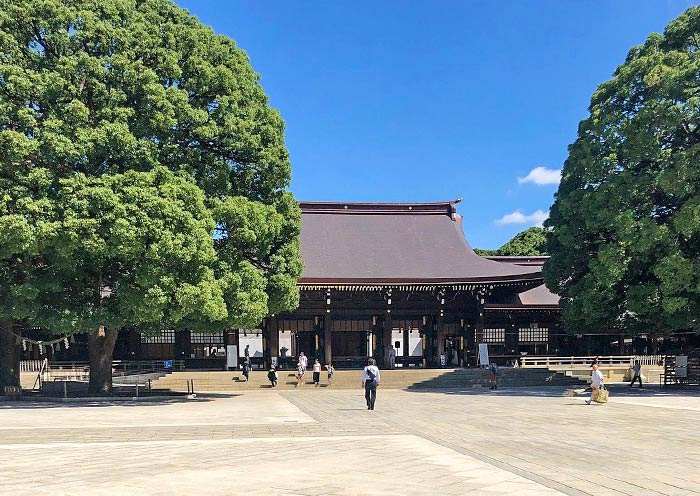
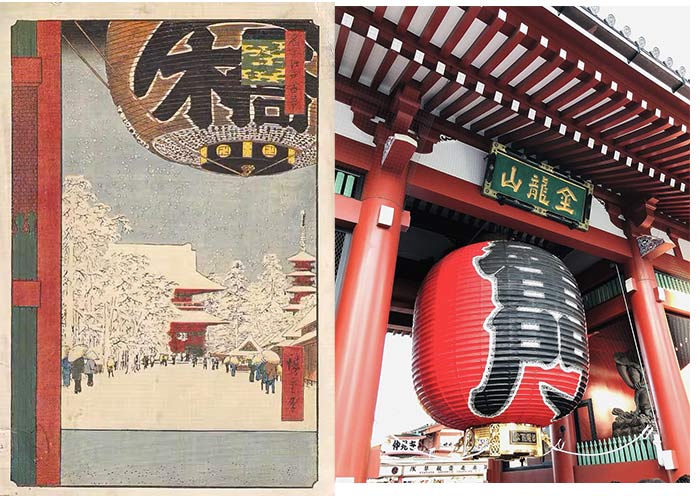
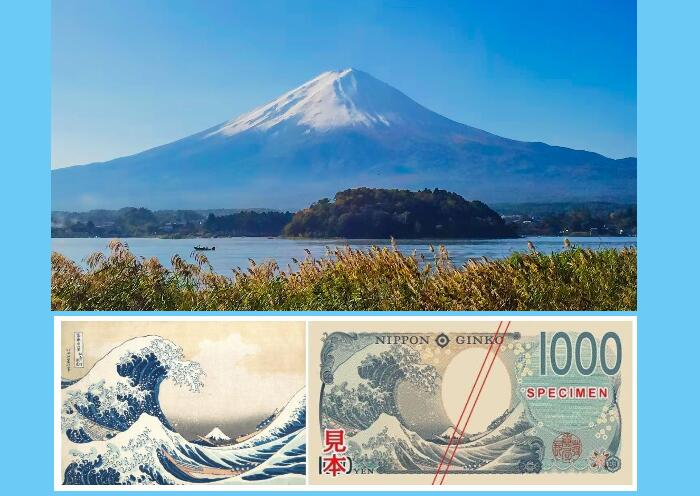
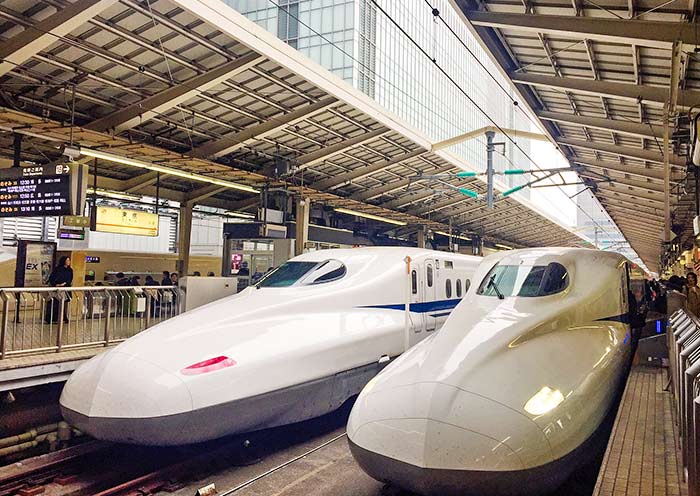



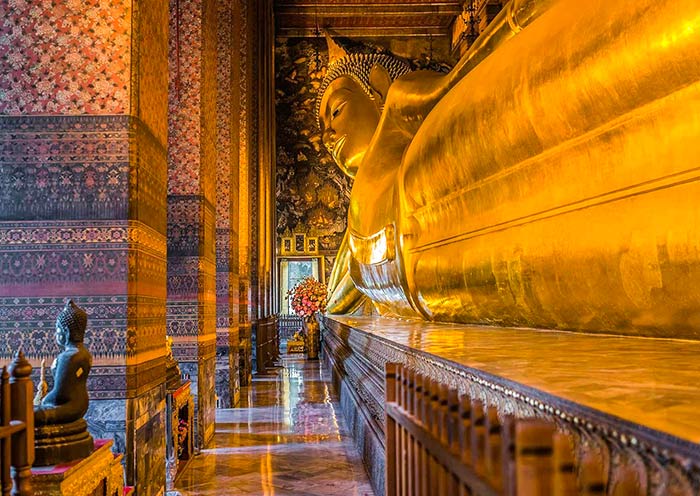

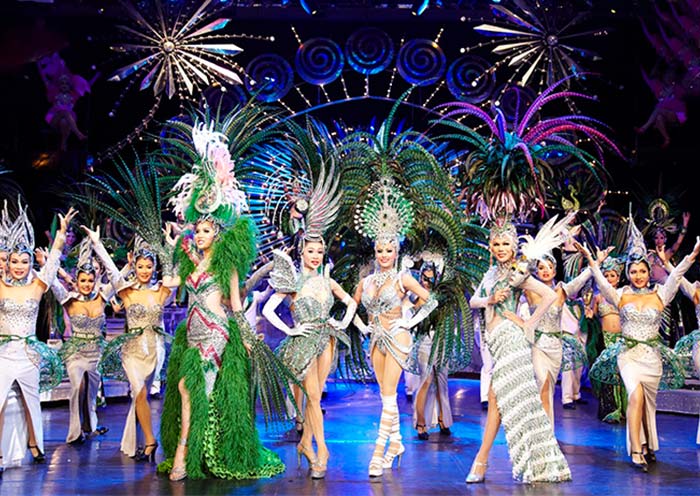


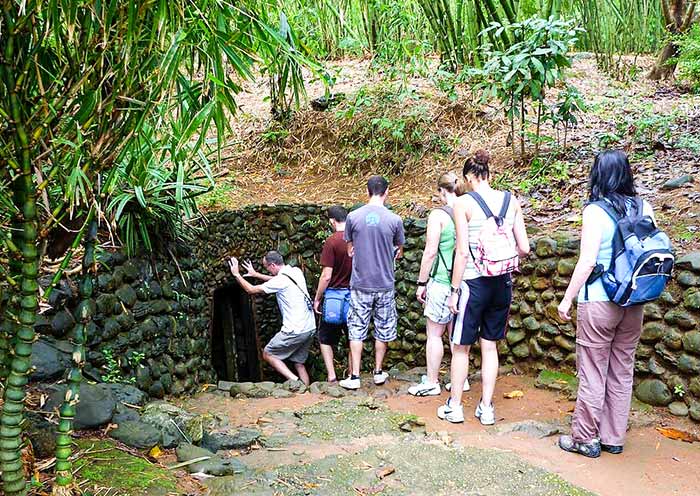




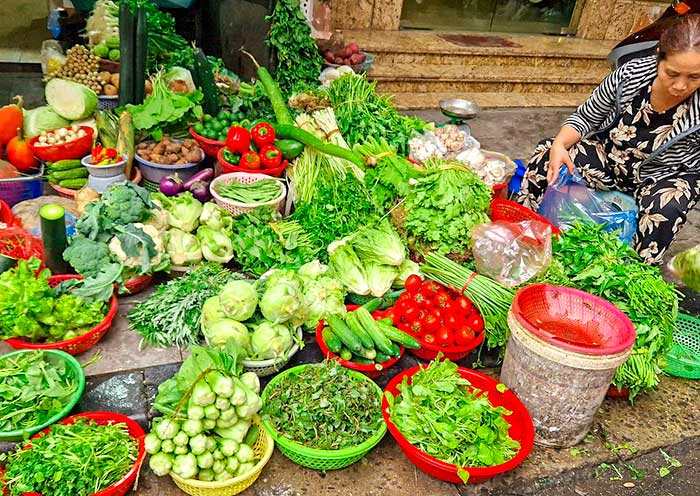
Itinerary at a Glance
Japan Tokyo (2.5 Days)
Meiji Jingu Shrine (Meiji Shrine; a Shinto Shrine), Shibuya Crossing, Senso-ji Temple (Asakusa Kannon Temple; a Buddhist temple; view Tokyo Skytree), Tsukiji Outer Market (Tsukiji Fish Market)
Japan Mt. Fuji (1 Day)
Mount Fuji 5th Station, Lake Kawaguchi, Kubota Itchiku Art Museum, Tenjo-san Park Cable Car or Lake Cruise
Japan Kyoto (2 Days)
Kinkakuji Temple (World Heritage), Nishiki Market, Gion, Yasaka Shrine, Ninenzaka & Sannenzaka, Kiyomizu-dera Temple (World Heritage), Fushimi Inari Taisha Shrine
Japan Nara (0.5 Day)
Todaiji Temple (World Heritage), Nara Park, Kasuga Taisha (World Heritage), Mt. Wakakusa
Japan Osaka (1.5 Days)
Osaka Castle Park,Shinsaibashi-suji Shopping Street & Dotombori District
Thailand Bangkok (1.5 Days)
Wat Phra Kaew, Grand Palace, Wat Pho, Chinatown, Wat Traimit, Wat Arun
Thailand Pattaya (2 Days)
Free exploration on your own; and you can choose to take island hopping to Koh Larn; enjoy Cabaret Show, Muay Thai fights; the Sanctuary of Truth Museum, Ripley's Believe It or Not!, Wat Phra Yai, Pattaya Floating Market, Dongba Paradise, Qizhen Fanshan
Thailand Bangkok - Cambodia Siem Reap (0.5 Day)
Depart Bangkok to Siem Reap
Cambodia Siem Reap (1.5 Days)
Angkor Complex: Angkor Wat & Sunrise, Ta Prohm, Angkor Thom, Phnom Bakheng & Sunset
Cambodia Siem Reap - Vietnam Ho Chi Minh City (1 Day)
Depart Siem Reap to Ho Chi Minh City
Vietnam Ho Chi Minh City (1.5 Days)
War Remnants Museum, Reunification Palace, Central Post Office, Nha Tho Tan Dinh, Cu Chi Tunnels, Jade Emperor Pagoda
Vietnam Mekong Delta (1 Day)
Vinh Trang Pagoda, My Tho boat trip, Ben Tre boat trip & cycling tour
Vietnam Ho Chi Minh City - Hanoi (0.5 Day)
Fly to Hanoi from Ho Chi Minh City
Vietnam Hanoi (2 Days)
Tran Quoc Pagoda, Ho Chi Minh Mausoleum, One Pillar Pagoda, Temple of Literature, Hanoi Train Street, Vietnam National Museum of History, Hoan Kiem Lake, cyclo tour to old quarter, Water Puppet Show (Optional)
Vietnam Halong Bay (2 Days)
Halong Bay, Halong Bay Cruise, Visit Sung Sot Cave, Titop Island, Trinh Nu Cave
Itinerary Day by Day
Konnichiwa(こんにちは)!Welcome to Tokyo, the capital city of Japan! Upon your arrival at the airport in Tokyo, your driver (not English-speaking) will meet you at the exit and then escort you to the hotel. You can have a good rest in your hotel and get ready to explore Tokyo with your guide the next day.
As one of Japan and Asia's largest economic centers, Tokyo is a hub for Japanese culture and art, with numerous museums, art galleries, theaters, and cultural venues, serving as a vital platform for artistic activities and cultural exchanges. Tokyo stands as a significant base for technological advancement, nurturing numerous high-tech companies and innovative talents, holding leading positions globally in areas like electronics, automotive, and robotics technology.
Situated at the southern end of the Kanto Plain, Tokyo is surrounded by diverse natural landscapes including Mount Fuji, providing residents with leisure and outdoor activity spaces. At one point, the population of the Tokyo metropolitan area reached 36 million, accounting for one-third of Japan's total population. Despite the high cost of living, Tokyo provides residents with convenient living conditions, offering a plethora of shopping centers, entertainment facilities, and a rich culinary culture ranging from fine dining to street food.
Arrival Ideas:
1. Japan has two commonly used international airports. Narita International Airport, located 63.5 km from the center of Tokyo, is the primary international air hub for Tokyo, where flights from China to Tokyo usually land. Tokyo International Airport (Haneda Airport), is situated 17 km from the center of Tokyo and mainly serves domestic flights within Japan and some international flights, including flights to South Korea and other East Asian regions.
2. Cities that have Direct Flights to Tokyo include, but are not limited to: Beijing, Shanghai, Guangzhou, Shenzhen, Hangzhou, Xi'an, Chengdu, Chongqing, Hong Kong, Taipei, Kaohsiung, Seoul, Singapore, Bangkok, Kuala Lumpur, Jakarta, Bali, Manila, Ho Chi Minh City, Hanoi, and more. Please note that flight information is subject to changes based on time and market demand. Contact us to obtain the latest flight information and prices.
3. In Japan, using public transportation such as the Subway JR trains is Recommended to save costs, avoid traffic congestion, and help reduce carbon emissions. Taxi Fares in Japan are relatively high, with a starting fare of around 660 Japanese yen and 140 yen per km. Waiting time is also charged. Surcharges are applicable during nighttime and peak hours (+20%), and expressway tolls are additional. Extra fees are levied for large luggage. For instance, a taxi ride from Tokyo Tower to Narita Airport, covering about 60-70 km,might cost around 25,000-35,000 Japanese yen (roughly 170-237 USD).

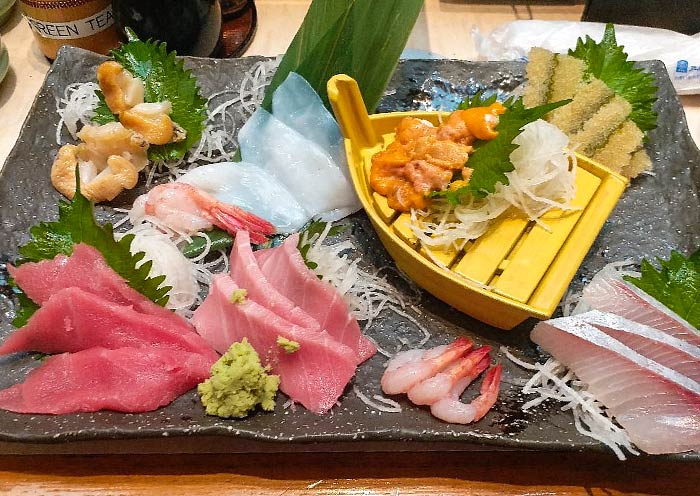
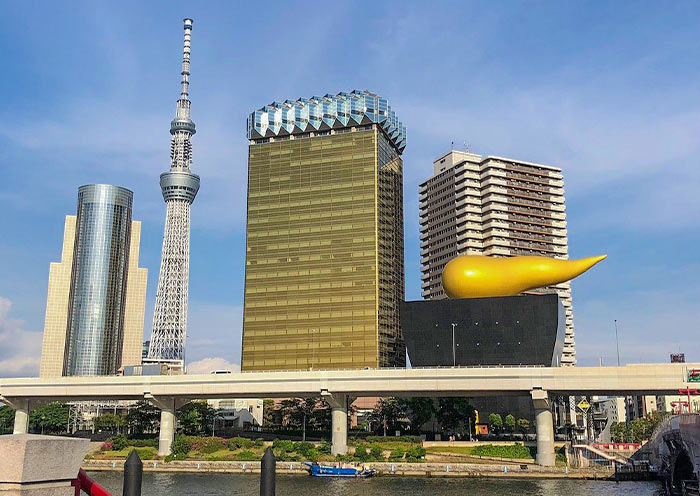
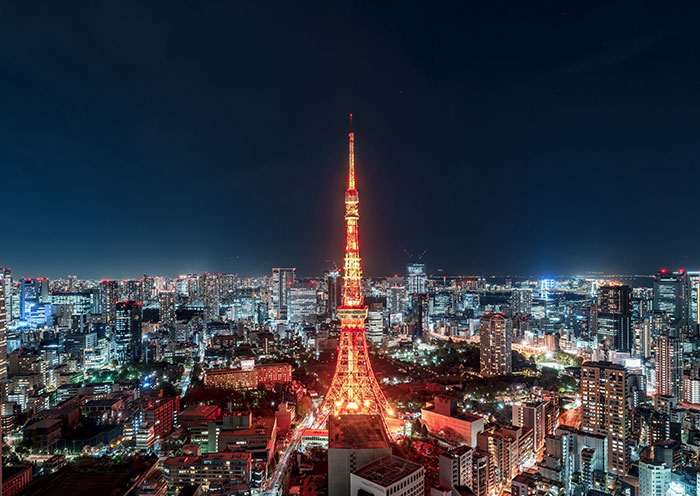
Full day explore Tokyo. You will visit Meiji Jingu Shrine (a Shinto Shrine; meet Japanese Wedding Procession), Shibuya Crossing, Senso-ji Temple (a Buddhist Temple; view Tokyo Skytree), Tsukiji Outer Market (Tsukiji Fish Market).
First to visit Meiji Jingu Shrine (Meiji Shrine), a Shinto Shrine dedicated to Emperor Meiji (1852-1912) and Empress Shoken (1849-1914), who played a crucial role in modernizing Japan while excelled in writing Waka (traditional Japanese poems of 31 syllables in the pattern 5-7-5-7-7). Meiji Shrine is a popular venue for traditional weddings, where you will have the opportunity to witness a Japanese Wedding Procession, experiencing the charm of Japanese traditional culture.
Founded in 1915 and finished in 1920, Meiji Shrine features a unique architectural style, with the main hall adopting traditional Japanese Shinto Shrine architecture infused with modern elements in its details. You will walk through Japan's Largest Wooden Torii Gate, standing in its natural wooden hue and weighing up to 13 tons. The Torii gate serves as the Symbol of Shinto Shrines, marking the transition from the worldly to the sacred. Walking through this gateway symbolizes stepping into the divine realm, evoking a profound sense of mystery and reverence.
As a peaceful oasis in the city, Meiji Jingu Shrine is the largest green space in the center of Tokyo. In the land-scarce city of Tokyo, the vast area occupied by the Meiji Shrine is truly astonishing! The sacred forest (170,000 trees) surrounding the main shrine buildings of Meiji Jingu is man-made, planted by 110,000 volunteers in honor of their beloved Emperor Meiji (established Shinto as the state religion) and Empress Shoken. The forest serves also to separate the sacred from the profane world.
Take a stroll along the paths and enjoy the fresh air and natural beauty. Then, you will notice the impressive Sake Barrel Wall along the South Approach, which features offerings from sake breweries and believers across Japan, including barrels of sake and Western liquor, reflecting Emperor Meiji's fondness for Western culture. At the main hall of Meiji Shrine, you can witness locals washing their hands and rinsing their mouths at Purification Font before worship as a sign of respect. You can offer a 5-yen coin (symbolizing a connection) like locals and pray for blessings. In the eyes of the Japanese, Meiji Shrine is considered to have such boundless capabilities, from naming ceremonies for newborns, to coming-of-age ceremonies, graduation ceremonies, seek marriage partners, pray for world peace, family well-being, safe travels, good health, warding off calamity, etc. In addition to immersing yourself in Japanese Shinto traditions and architecture, revel in the enchanting surroundings filled with lush trees, serene ponds, graceful bridges, and stone pathways that epitomize the essence of traditional Japanese garden art. You should visit here to enjoy the vibrant bloom of cherry blossoms in spring, the verdant beauty of summer, the fiery hues of autumn leaves, and the serene snowy landscapes of winter.
Tips for Visiting Meiji Jingu Shrine:
1. Wear modest clothing: Respect the sacred nature of the shrine by dressing appropriately.
2. Be mindful of noise levels: Maintain a quiet and respectful atmosphere.
3. Inner Garden (Optional; self-pay; once Imperial Property), and Meiji Jingu Museum (Optional; self-pay; items used by the imperial couple).
Then, move to visit Shibuya Crossing, one of the busiest intersections in the world, accommodating approximately 3,000 people per minute. As one of Tokyo's iconic locations, Shibuya attracts tourists and photographers from around the globe who come to observe and capture its essence. Numerous movies, TV shows, commercials, and music videos are filmed at this location, such as "Detective Chinatown 3" and "The Fast and the Furious: Tokyo Drift." Additionally, the well-known story of Hachiko the Loyal Dog originates here. Hachiko, an Akita dog, continued to visit the station daily to await his deceased owner's return. The Hachiko Statue located in front of Shibuya Station stands as a significant cultural landmark in the Shibuya area, attracting numerous visitors annually who come to pay their respects and honor his loyalty.
In the afternoon, head to Senso-ji Temple (Asakusa Kannon Temple), a must-visit for anyone traveling to Tokyo. Here, you can experience the heart of old Tokyo and its vibrant atmosphere. You can take photos that frame Senso-ji Temple and the Tokyo Skytree;(Japan's Tallest Tower; 634 meters) together.
Senso-ji Temple was built in 628 AD and has a history of over 1300 years, making it one of Japan's oldest temples. It not only witnesses Japan's historical changes but also carries a rich Buddhist culture. The architectural style of Senso-ji Temple blends Japanese traditional culture and art, with rich colors and exquisite carvings. The main buildings include the main gate (Kaminarimon; a landmark of Tokyo), the bell tower, the Five-story Pagoda (a landmark of Tokyo), and the main hall, all reflecting ancient Japanese architectural style and religious beliefs.
Kaminarimon is the iconic structure of Senso-ji Temple, towering at 11.7 meters high and 21.7 meters wide, truly spectacular. Giant Red Lanterns hang in front of the gate, with the words "Kaminarimon" prominently displayed. Kaminarimon is not only a symbol of Senso-ji Temple but also one of Tokyo's most famous landmarks. You may have seen the work of Utagawa Hiroshige, one of the "Three Greats of Ukiyo-e," in his piece "One Hundred Famous Views of Edo: Asakusa Kaminarimon," depicting a snowy scene of the Kaminarimon gate, celebrated for its delicate portrayal and profound imagery, becoming a masterpiece of Ukiyo-e art. The area is bustling, and crowded with people coming to pray and seek blessings for health, peace, and happiness. Around Senso-ji Temple, you can taste various Japanese cuisines, purchase unique souvenirs, and participate in various celebratory activities.
After that, you can explore Tsukiji Fish Market (Now Toyosu Market). Tsukiji Fish Market was once the world's largest fish market, famous for its tuna auctions. However, in 2018, it relocated to a new, larger facility called Toyosu Market. You can still enjoy fresh seafood (sashimi, sushi, or seafood rice bowls), purchase kitchenware, and learn about a variety of seafood, including the characteristics, cooking methods, and nutritional value of different types of seafood.
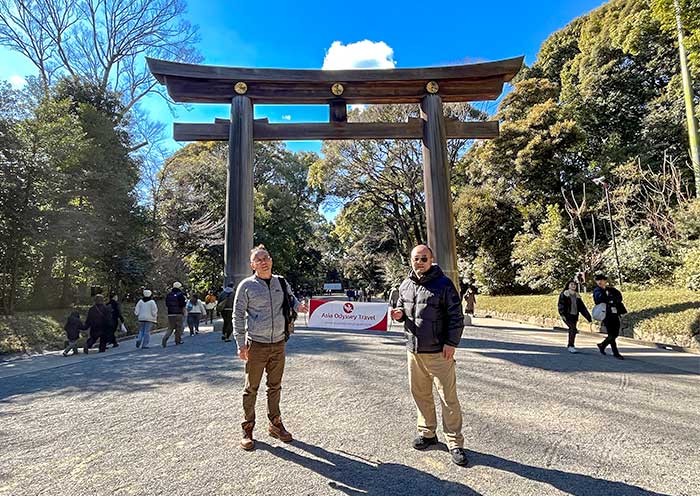
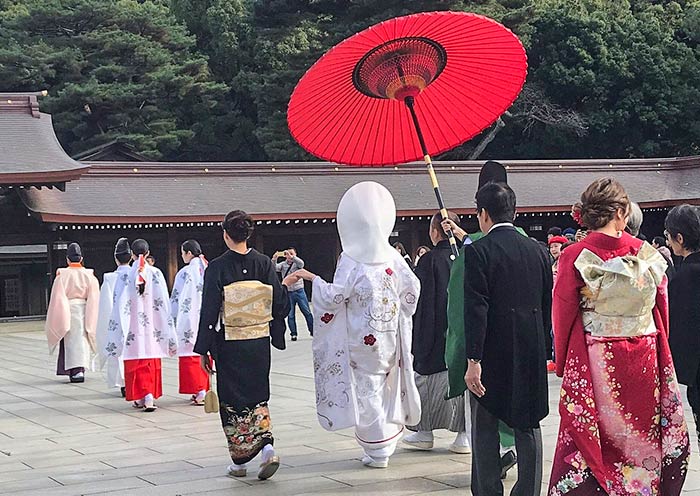

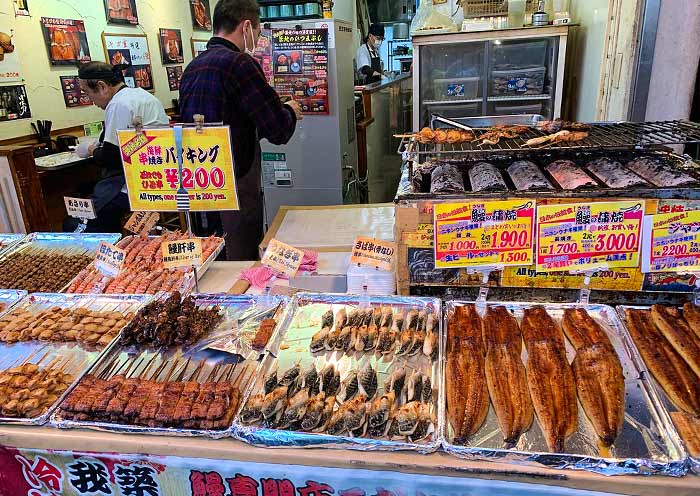
Today, it will be a full-day round trip (300 km) to admire the breathtaking views of Mount Fuji from the Mount Fuji 5th Station, Lake Kawaguchi.
Mount Fuji is the tallest mountain in Japan. It's a famous volcano with a perfectly symmetrical cone shape. Visiting Mount Fuji is essential for any traveler in Japan. As a UNESCO World Heritage Site, Mount Fuji (3,776 m) stands as an iconic symbol of Japan, a cultural and spiritual landmark (recognized as a holy mountain in Shintoism), and a natural marvel. When picturing Mount Fuji, its distinctive perfect cone shape and snow-capped peak likely come to mind. Among the most renowned depictions is Katsushika Hokusai's 'Thirty-Six Views of Mount Fuji'. Hokusai, one of the "Three Greats of Ukiyo-e," is best known for his masterpiece "The Great Wave off Kanagawa."
Start your journey to Mount Fuji 5th Station for a close-up Mount Fuji view. It offers breathtaking panoramic views of Mount Fuji (if weather permits) and the surrounding area, including the Fuji Five Lakes. For those adventurous enough, the 5th Station is the starting point for climbing Mount Fuji. Experience the unique alpine environment and the thrill of being so close to Japan's iconic mountain.
Then, head to Lake Kawaguchi for a leisurely walk along the lakeside. Lake Kawaguchi is renowned for its clear waters that often reflect the majestic Mount Fuji (if weather permits), creating a postcard-perfect scene and making it a popular destination for both domestic and international tourists.
For art lovers, the next stop is the Kubota Itchiku Art Museum, located near Lake Kawaguchi. This unique architectural space houses a collection of beautiful rare kimonos, all designed and created by artist Ichiku Kubota. Ichiku Kubota (1917–2003) was a master textile artist renowned for his exquisitely crafted kimonos. He developed his own complex dyeing techniques, creating intricate patterns and colors inspired by nature, landscapes, and traditional Japanese culture. The tranquil museum setting also offers beautiful views of Mt. Fuji and the lake.
After exploring the museum, choose between two scenic experiences: a cable car ride at Tenjo-san Park or a peaceful cruise on Lake Kawaguchi.
Tenjo-san Park (Cable Car): Take a scenic cable car ride up to the park’s observation area. From the top, you’ll be treated to a stunning 360-degree view of Mt. Fuji, Lake Kawaguchi, and the surrounding countryside.
Alternatively: Lake Kawaguchi Cruise: If you prefer a more tranquil experience, you can opt for a lake cruise on Lake Kawaguchi. This leisurely boat ride offers beautiful views of Mt. Fuji from the water, allowing you to appreciate the landscape from a different perspective.
After that, head back to Tokyo overnight and have a good rest.
Notes:
If the weather is clear, you can enjoy a good view of Mt. Fuji. However, if the weather is not favorable, Mt. Fuji may not be visible.
The best time to view Mount Fuji is generally from Nov. to Feb. when skies are clearer and the peak is snow-capped. Nevertheless, it's important to keep in mind that weather can be unpredictable, and even during these months, there is no guarantee of a clear view.
Early mornings often provide the best visibility before clouds obscure the view. Different locations around Mount Fuji offer varying perspectives, with some spots known for their clear views.


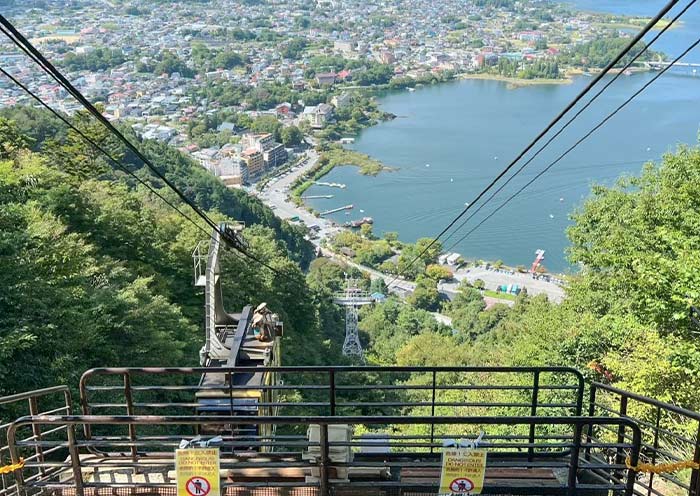
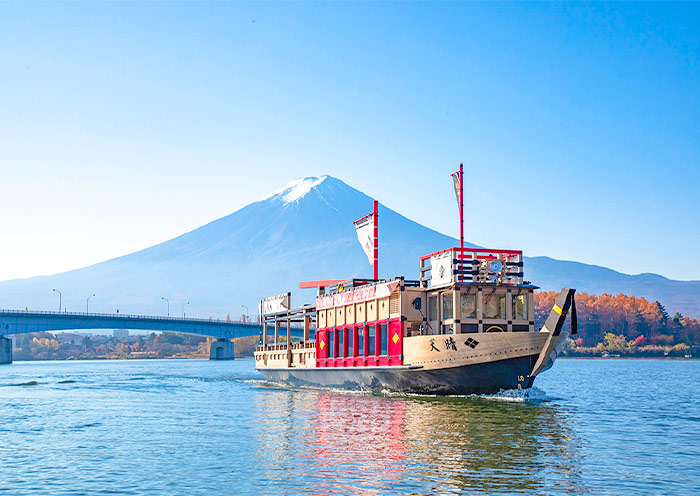
Today, you will take the Shinkansen (Bullet Train) to Kyoto from Tokyo Station. A driver will wait for you at the hotel entrance at the scheduled time and transport you to Tokyo Station.
Shinkansen Ride: At Tokyo Station, board the Shinkansen (Bullet Train) bound for Kyoto Station (about 2.5 hours). This fast and comfortable journey offers a chance to enjoy the changing landscapes of urban and rural Japan. Tokyo Station, a prominent feature on the ¥10,000 Japanese banknote, is more than just a transportation hub, it is a historical landmark and a vibrant destination in its own right. As the main gateway to the city, Tokyo Station has played a crucial role in Japan's modernization and economic development. Its impressive red-brick facade and intricate details are a testament to Japanese architectural prowess. The station has become a symbol of Tokyo and a popular tourist attraction.
Upon arrival in Kyoto, your driver will greet you and transfer you to your hotel. Check in, take some time to settle in, and rest.
Kyoto, located in the Kansai region of the country, was once the capital of Japan. It epitomizes ancient Japan and is famous for tranquil temples, exquisite gardens, colorful shrines, grand imperial palaces, and ornate castles. Boasting 17 UNESCO World Heritage Sites, over 1,000 Buddhist temples, and more than 400 Shinto shrines, Kyoto is among the world's most culturally rich cities. It's also known for traditional Japanese arts and practices, such as tea ceremonies, kaiseki dining (a traditional multi-course meal), and ikebana (flower arranging). It remains one of the best places to see geishas, who are traditional Japanese female entertainers known for their refined skills in arts, music, dance, and conversation.
Free Time Ideas in Kyoto:
1. Evening Stroll Along the Kamo River: This river flows through the city and provides walking paths with beautiful views. Many cafes and restaurants along the river have terraces, perfect for a relaxing end to your day.
2. Walk the Philosopher's Path: Enjoy a peaceful walk along the Philosopher’s Path, a stone path lined with cherry trees that follows a canal in northeastern Kyoto. This path is especially beautiful during cherry blossom season but offers a serene experience year-round.



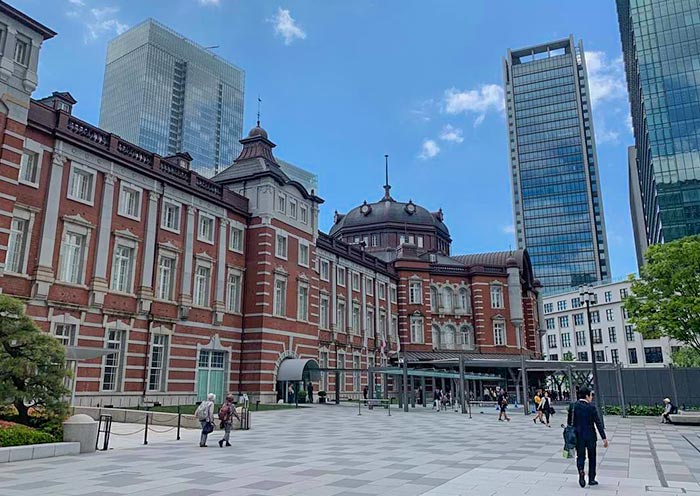
Today, you will experience the rich culture and history of Kyoto, from its ancient temples, shrines, and castles to its vibrant market and traditional district.
Start your day with a visit to one of Kyoto's most iconic sights, Kinkakuji Temple (Golden Pavilion) - a UNESCO World Heritage site. This Zen Buddhist temple is famous for its stunning golden exterior. The temple's stunning visual appeal comes from its top two floors, which are completely covered in gold leaf. The reflection of the golden structure shimmering in the pond in front of it, making it perfect for photos and quiet reflection. It was originally built in 1397 as a retirement villa for Shogun Ashikaga Yoshimitsu. After Yoshimitsu's death, as per his will, the villa was converted into a Zen temple by his son.
Next, make your way to Nishiki Market, often called "Kyoto’s Kitchen." This vibrant market is the perfect place to sample a variety of local dishes, such as cute Japanese sweets wasabi salt, fresh sashimi skewers to tako tamago (small octopus head stuffed with a quail egg on a stick). Enjoy browsing through the stalls and trying different Kyoto delicacies.
After lunch, head to Gion, Kyoto's famous geisha district. Here, you might catch a glimpse of Geisha (Geiko) in their elaborate kimonos and traditional makeup. As you wander through the cobblestone streets of Gion, take a moment to appreciate the beautifully preserved machiya (wooden townhouses), ochaya (teahouses), and exclusive ryotei (traditional Japanese restaurants).
From Gion, a short walk will bring you to Yasaka Shrine, the guardian shrine of the Gion entertainment district, which dates back over 1350 years. Yasaka Shrine is particularly favored by those seeking beauty and wealth. Visiting this significant Shinto shrine in Kyoto, you may also find yourself gaining some good luck. The shrine is most famous for its Gion Matsuri in July, during which you can witness the procession where the deities of Yasaka are paraded through the city streets.
Then, walk up the well-preserved streets of Ninenzaka and Sannenzaka towards Kiyomizu-dera Temple. These charming, sloping streets are lined with traditional shops and quaint tea houses, offering a nostalgic glimpse into Kyoto's past. As you stroll through these areas, you can shop for unique crafts, sample local snacks, and perhaps stop at a café to relax and soak in the atmosphere of old Kyoto.
Your day culminates with a visit to Kiyomizudera Temple, another UNESCO World Heritage Site. Perched on the hillside of Eastern Kyoto, this temple is renowned for its wooden stage that juts out over the hill, providing stunning views of the city and the surrounding nature. The temple's main hall, constructed entirely without the use of nails, is an architectural marvel. Kiyomizu-dera is also celebrated for its sacred waters, which are believed to have wish-granting powers that draw countless visitors who come to drink from its stream. Don’t miss the Hondo (Main Hall), Jishu Shrine, the Otowa Waterfall, and the spiritual experience of the Tainai-Meguri room.
Tips: The scenery at Kiyomizudera Temple is distinctively beautiful in each season, offering a unique charm year-round. In spring, the mountains are adorned with charming cherry blossoms; in summer, they are lush with vibrant greenery; in autumn, they are decorated with brilliantly colored leaves; and in winter, they are filled with enchanting trees.
Stay overnight in Kyoto.
Optional Activities:
- Join a geisha tea ceremony in Kyoto.It offers a chance to see a performance by a geisha, experience the tea ceremony, and learn all about its artful rituals.
- Kyoto traditional kimono experience.Wear a traditional kimono and stroll through scenic districts like Gion or around Kiyomizu-Dera Temple. Enjoy photo opportunities and the feel of traditional Japan.
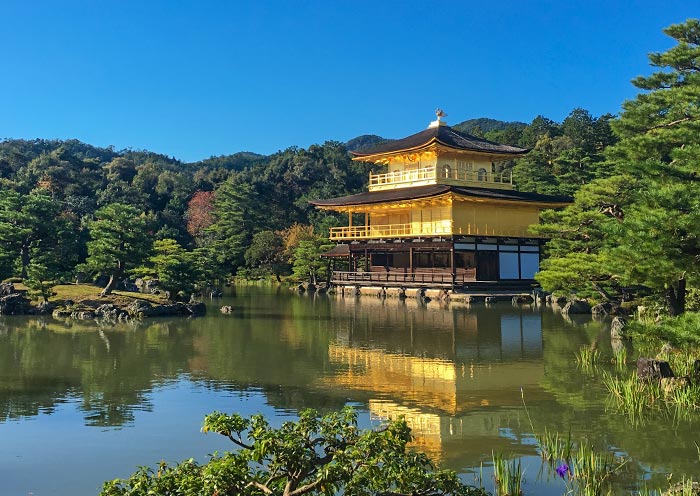



Start morning in Kyoto bright and early at one of its most iconic sites - the Fushimi Inari-taisha Shrine to beat the crowds.
Fushimi Inari-taisha Shrine is famous for its thousands of vermilion Torii Gates, known as Senbon Torii (thousands of Torii Gates). Layers upon layers of vermilion torii gates line the lush, wooded hillside, forming a seemingly endless corridor. The vibrant orange and black gates contrast beautifully with the surrounding greenery, creating a visually stunning and almost otherworldly path that is highly photogenic.
Fushimi Inari-taisha was founded in the early 8th century (711 AD) and is primarily dedicated to Inari, the Shinto god of rice, fertility, sake, agriculture, and industry. As you explore the shrine, you will encounter hundreds of Fox Statues. Said to be the messengers of the God Inari, who is associated with cereal grains, these fox statues often symbolize the deity. Many of these fox statues are depicted holding a key in their mouths, which is said to open the granary.
Tips: Hiking to the summit of the mountain and back will take two to three hours, but many people go only as far as the Yotsutsuji intersection because there are fewer torii gates beyond this point. It will take 30 to 40 minutes to reach Yotsutsuji.
Depart from Kyoto and head to Nara, an approximately 1.5-hour car ride. Before Kyoto, there was Nara, Japan’s first permanent capital and one of the country’s most rewarding destinations. Nara boasts 8 World Cultural Heritage Sites, making it Japan's second most culturally rich city after Kyoto.
Visit Todaiji Temple, one of Japan's most historically significant temples and a UNESCO World Heritage Site. It is known for housing the world’s largest bronze statue of the Buddha Vairocana, which stands just over 16 m high and consists of 437 tonnes of bronze and 130 kg of gold. It represents Vairocana Buddha and is flanked by two Bodhisattvas. Todaiji's main hall, Daibutsu-den (Big Buddha Hall), is one of the world's largest all-wood buildings, even though the present reconstruction of 1692 is only two-thirds of the original temple hall's size.
Walk to Nara Park, adjacent to Kasuga Taisha. This park is famous for its hundreds of freely roaming deer, considered messengers of the gods in Shinto tradition. Purchase some Shika Senbei (deer crackers) to feed the deer as you stroll through the park.
Head to Kasuga Taisha (Kasuga Grand Shrine), Nara’s most celebrated Shinto shrine, another UNESCO World Heritage Site. It is renowned for its lanterns, which have been donated by worshippers. Hundreds of bronze lanterns can be seen hanging from the buildings, while thousands of stone lanterns line its approach and the surrounding woods. These lanterns are lit twice a year during the Lantern Festivals in February and August, creating an ethereal and mesmerizing atmosphere.
Hike up Mount Wakakusa (Wakakusa Yama), from where you can enjoy panoramic views of Nara and its surroundings. The hike is relatively easy and offers a great opportunity to relax and take in the natural beauty of the area. The real thrill is that you may encounter friendly deer. The mountain is especially beautiful during the cherry blossom season and autumn when the foliage changes color.
After the tour, drive to Osaka (typically takes around 45 minutes to an hour) and stay overnight.
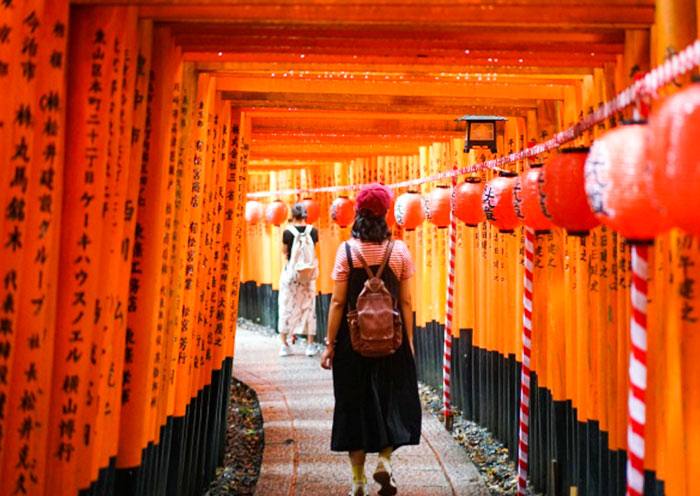
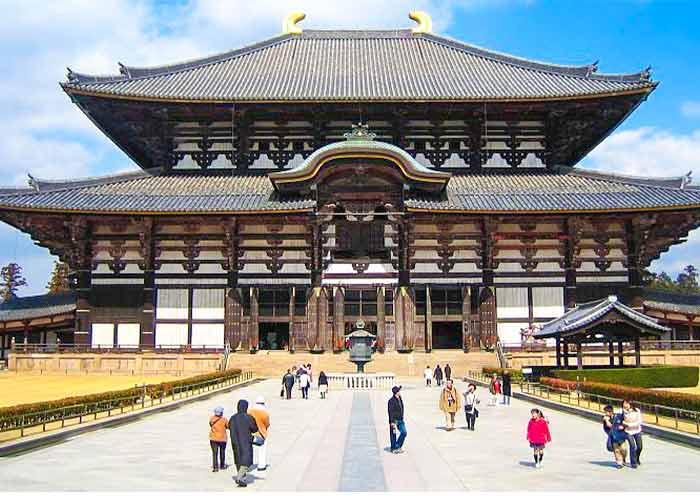


Osaka, Japan's third-largest city and a major economic hub, is renowned for its rich history, diverse cuisine, distinctive culture, and robust economic strength. The city's unique sense of humor and open personality make it an exceptionally interesting place, more colorful than most cities. Acres of concrete are covered with dazzling neon lights and brightly colored storefronts. Osaka is a city that loves to eat, known as the "nation's kitchen." It boasts a wide variety of culinary delights.
Start your day at Osaka Castle Park, one of Japan’s most famous landmarks and a symbol of Osaka’s historical grandeur. Originally built in 1583 by Toyotomi Hideyoshi, a powerful daimyo who aimed to unify Japan, it was the largest castle of its time. After multiple renovations and reconstructions, today's Osaka Castle has been transformed into an open park, covering a total area of 105.6 hectares, making it a must-visit attraction.
Walking into the scenic area of Osaka Castle, you'll be amazed by the massive scale and precision of the moats, gates, and stone walls. The largest stone slab is 11 meters wide, and many stones are inscribed with the crests of the 64 daimyō (feudal lords) tasked with the castle’s construction back in 1620. The most breathtaking feature is the Main Tower (Tenshukaku) of Osaka Castle, which stands tall against the sky at the center of the extensive castle grounds. The castle tower's interior is a museum showcasing artifacts related to Toyotomi Hideyoshi and the castle's history. The observation deck on the 8th floor offers a panoramic view of Osaka Castle Park and the Osaka Plain.
Optional Activity: Take some time to stroll through the Nishinomaru Garden, which offers a picturesque setting with over 600 cherry trees and beautiful views of the castle tower from below. This is especially enchanting during the cherry blossom season, which usually occurs in late March and/or early April.
In the afternoon, you will experience the unique charm of the city through a street food and shopping tour. Enjoy shopping at Shinsaibashi-suji Shopping Street, Osaka's busiest shopping arcade. Then, head to the lively district of Dotonbori, where waterways are lined with luminous advertisements and signs. It's especially glitzy during the holiday season, with decorations strung across the bridges. Full of fantastic restaurants, clubs, and karaoke bars, it's the city's go-to area for entertainment. Take a photo at the iconic Glico Man sign. Try takoyaki, ball-shaped octopus bites, kushikatsu (Japanese deep-fried skewered meat and vegetables), and okonomiyaki, a savory Japanese pancake topped with whatever you like.
Optional Activities:
Kamigata Ukiyoe Museum offers a fascinating glimpse into the traditional Japanese art form of ukiyo-e.
Shinsekai (New World) & Tsutenkaku Tower: Shinsekai, meaning "New World," is a nostalgic and unique shopping district in Osaka, known for its retro vibe, old-school charm, and vibrant atmosphere. Originally built in 1912, Tsutenkaku Tower offers views of the Osaka skyline and is located in the retro-themed Shinsekai area.


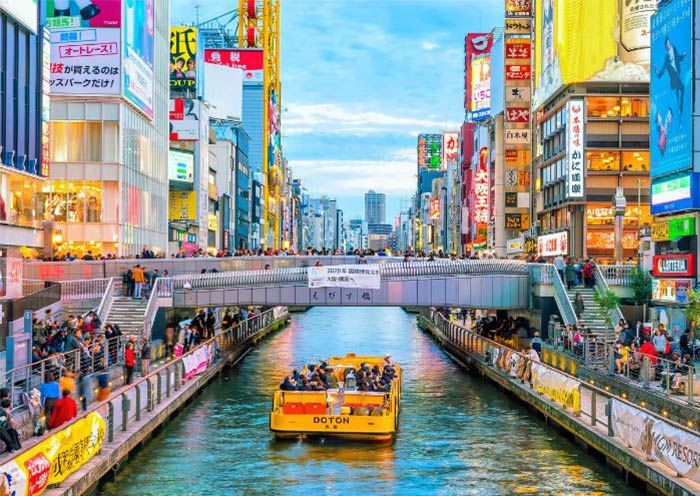
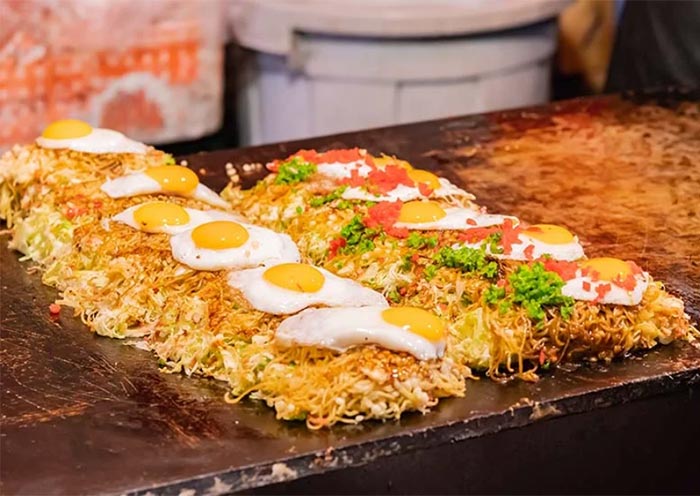
Sawatdee Krap/Kha! Welcome to Bangkok, the capital city of Thailand! Upon your arrival at the airport in Bangkok, the tour guide and driver will meet you at the exit and then escort you to the hotel in downtown Bangkok. You can have a good rest in your hotel and get ready to explore Bangkok with your guide the next day.
Bangkok means the "City of Angels" in translation from its ceremonial Thai name, Krung Thep Maha Nakhon. It is a vibrant metropolis known for its bustling markets, ornate temples, and delicious Thailand street food. You can indulge in Bangkok's diverse culinary scene, from street eats to upscale dining. Shop till you drop in luxury malls or explore local markets. Enjoy the city's lively nightlife, rooftop bars, and live music venues. Bangkok offers a blend of tradition and modernity, making it an exciting and captivating destination.
Free Time Ideas:
1. You can watch a Thailand boxing game at Rajadamnern Stadium.
2. Unwind with a traditional Thai massage or spa treatment.
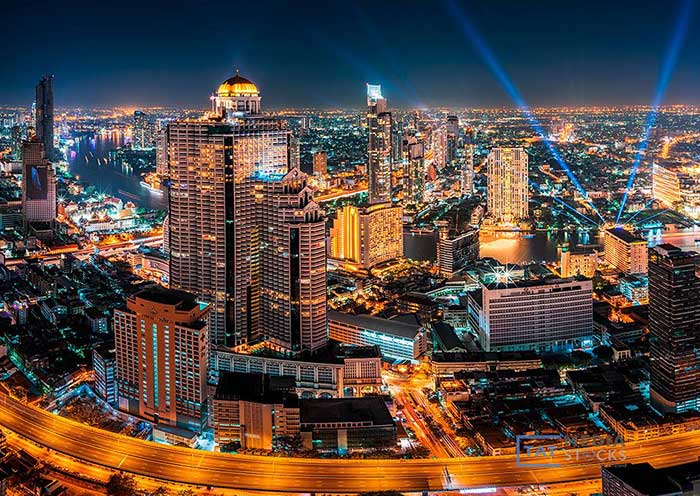
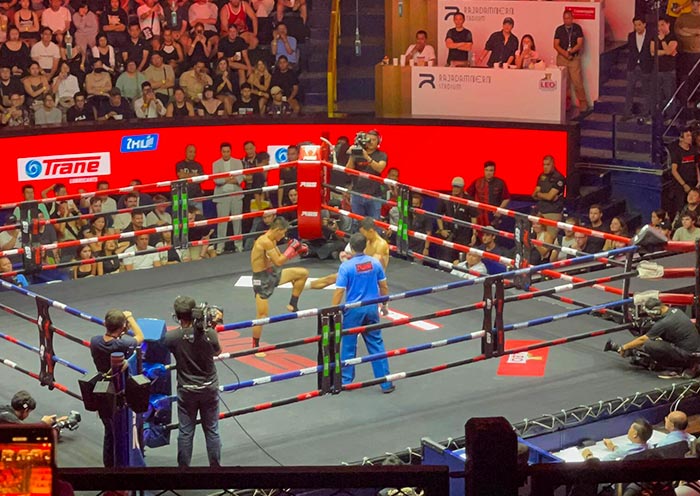
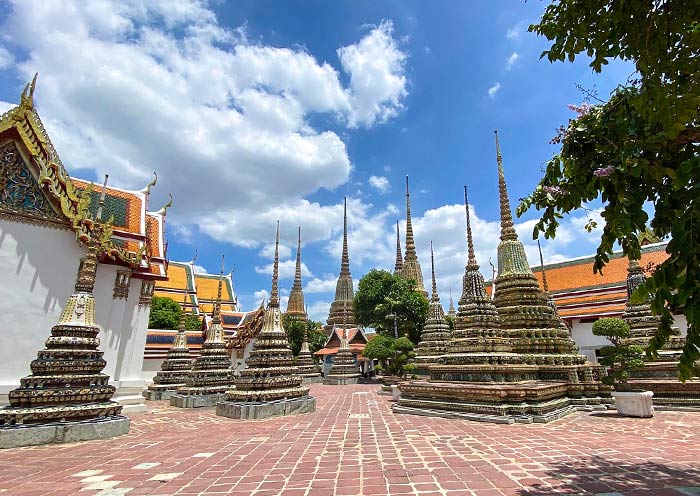
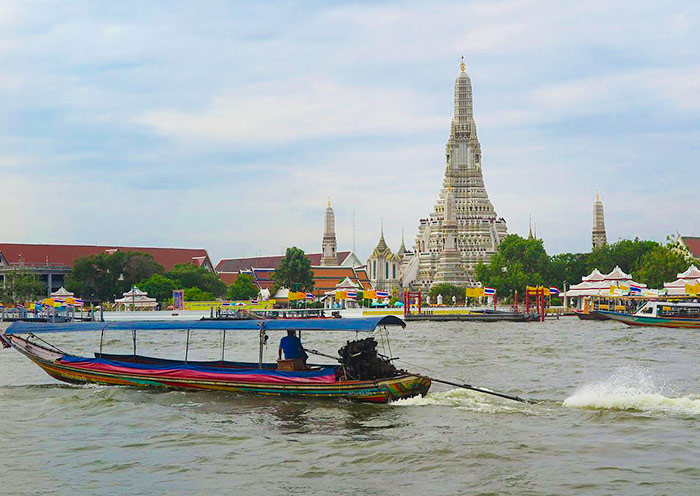
Today, you will explore the Top 6 must-visit places in Bangkok: Wat Phra Kaew, Grand Palace, Wat Pho, Chinatown, Wat Traimit, and Wat Arun. You see “Wat” means “Temple” in Thai language. You will also experience a Thai tuk-tuk, take a ferry or boat ride on the Chao Phraya River, and indulge in local food in Chinatown. This is a classic Bangkok trip, allowing you to witness 3 treasures of Thailand: the jade Buddha, the reclining Buddha, and the golden Buddha.
In the morning, head to Wat Phra Kaew which was built in 1782 and is located in the northeast corner of the Grand Palace in Bangkok. Covering one-fourth of the Grand Palace's area, Wat Phra Kaew is the most famous royal Buddhist temple in Thailand. This temple is renowned for enshrining one of three national treasures of Thailand, the Emerald Buddha, which is carved from a single block of Emerald. Each year, the Thailand King personally changes the Buddha's robes according to Thailand's three unique seasons. Each season changes with a certain robe: a gold robe embedded with rubies for the hot season, a gold robe embedded with sapphires for the rainy season, and a pure gold robe for the cool season. Don’t forget to check which robe the Emerald Buddha wears when you are there.
On the walls surrounding the cloisters of Wat Phra Kaew, there are a total of 178 murals (1,000m in length). Painted during the reign of King Rama I, the first monarch of the Chakri Dynasty in 18th-century Thailand (Bangkok Dynasty), the murals depict scenes from the Indian mythological epic "Ramayana," which narrates the story of King Rama joining forces with the monkey deity Hanuman to defeat the demon king Ravana and rescue the exquisite princess Sita. It is said that the story of the "Journey to the West" is also based on this legend. All the murals were created by royal court painters and the golden pigments used were made entirely from gold, resulting in exquisite and unparalleled artwork.
With the guidance of your tour guide, you can learn about the mythical creatures within Thai Buddhist architecture. For example, there is the Garuda, a mythical bird and guardian deity of Buddhism, perched on the rooftops. At the entrance of the temple, you'll find Yaksa, a protective deity, and outside the halls, there are statues of Kinaree, a mythical half-bird, half-human creature. The base of the pagoda is adorned with statues of Hanuman, the monkey deity.
After visiting Wat Phra Kaew, you can go on a visit around the Grand Palace. The Grand Palace, which was first established in 1782, was constructed as a replica of the old palace in the former capital city of Ayutthaya. It serves as a symbol of the Bangkok Dynasty and is the most well-preserved, largest, and most distinctive palace in Thailand. The Grand Palace is currently used for coronation ceremonies, royal celebrations, and hosting foreign dignitaries. From King Rama I to King Rama VIII, all the monarchs of the Bangkok Dynasty resided in the Grand Palace. However, after an assassination incident in 1946 involving King Rama VIII, King Rama IX moved to a new residence. The Bangkok Dynasty has continued to the present day, with the current monarch being King Rama X.
The Grand Palace complex consists of 22 buildings and is elegantly situated along the banks of the Chao Phraya River. The main structures are four distinct palaces (Borombhiman Hall, Amarindra Hall, Chakri Mahaprasat, Dusit Hall), showcasing the essence of Thai architecture, painting, sculpture, and interior decoration. It is often referred to as the "Encyclopedia of Thai Art". By the way, the Thai King is considered the incarnation of the god Vishnu, and Garuda is Vishnu's guardian. As a result, sculptures of the Garuda (stepping on 2 serpents) can be found on door lintels, eaves, and walls, with a total count exceeding several hundred. Witnessing the changing of the guards' ceremony is a bonus when visiting the Grand Palace.
Then, visit Wat Pho (Temple of the Reclining Buddha) which is a 10-minute walk from the Grand Palace. As the oldest and largest temple in Bangkok, Wat Pho houses the largest reclining Buddha and the highest number of Buddha images and stupas in the city. The reclining Buddha, one of three national treasures of Thailand, is 46 meters tall and 108 meters long, depicting the scene of the Nirvana of Gautama Buddha. Within the temple grounds, there is a Bodhi tree, believed to be the spot where the Buddha meditated. The temple is adorned with about 100 stupas, with the most magnificent being the four stupas which are decorated with blue, white, yellow, and green ceramic tiles. In the courtyard, you can also see many Chinese-style stone sculptures, such as door guardians and lions, which were traditionally used on ships for ballast and protection against evil spirits.
Wat Pho is regarded as Thailand's first university and is considered the birthplace of Thai medicine and traditional Thai massage. It still houses a private school established in 1957 that teaches traditional Thai medicine and offers authentic Thai massages (optional, self-pay).
Head to Chinatown Bangkok for lunch. Chinatown Bangkok (Yaowarat) is renowned as one of Bangkok's liveliest and most bustling commercial areas, with reportedly 70% of the city's gold shops located in Chinatown. It is also home to Wat Traimit, the world's largest solid gold Buddha statue. The entire street of Chinatown stretches for about 2 km, lined with numerous shops, and thousands of businesses proudly displaying eye-catching Chinese signs. You may have watched the film Detective Chinatown, which was filmed in Chinatown Bangkok which has a history of over 200 years. You can search for the hidden shops that appeared in the film while enjoying the food in Chinatown, a haven for foodies. The restaurants and food stalls here provide a rich selection of Chinese, Thai, and other Asian delicacies. From classic pad thai to exotic grilled meats, there's something for everyone.
After lunch, visit Wat Traimit (Temple of the Golden Buddha). Built in 1785, it is renowned for housing the world's largest gold Buddha. The gold Buddha (one of three national treasures of Thailand) inside the temple weighs 5.5 tons and stands at a height of 3 meters. It was constructed with the contributions of 3 Chinese individuals, hence it is also known as the Three Chinese Temple or Three Friends Temple. The royal family holds annual ceremonies here to welcome the New Year. Unlike other temples, photography is allowed inside the temple hall in designated areas(video recording is not permitted). From fourth floor of the Wat Traimit, you can enjoy a distant view of the tallest building in Thailand (314m), the King Power Mahanakhon (Pixel Tower).
In the afternoon, take a tuk-tuk ride to the pier via a quick stop at Pak Khlong Talat Flower Market, also known as Bangkok Flower Market, which is one of the top 9 flower markets in the world. Then, take a ferry or boat (cruise; optional) on the Chao Phraya River to view Wat Arun (outside view). The Chao Phraya River divides Bangkok into two parts, and many famous temples are concentrated along its banks. The Wat Arun, is one of the most prominent temples that stands on the river's edge, complementing the Grand Palace on the opposite side. (Note: Due to the hot weather and the presence of numerous steps at Wat Arun, many of our guests opt to take a boat trip and enjoy the view of Wat Arun from the outside, either from the boat itself or from the opposite side.)
Built in 1809, Wat Arun was established to honor King Taksin (郑信), the 41st monarch of Thailand (1767-1782) and a national hero. During the invasion of the Burmese army, King Taksin led the Thai people in a brave resistance, successfully driving out the Burmese and establishing the Thonburi Kingdom. To commemorate this Chinese-Thai king (from Guangdong), the temple was named Wat Arun, meaning "Temple of Dawn", as the battle took place at dawn. The main stupa of the temple stands at a height of 79 meters and is often referred to as the Thai version of the Eiffel Tower. In contrast to many other magnificent temples adorned with gold, Wat Arun stands out with its elegant white structure, attracting numerous visitors who come to rent traditional Thai costumes for photography. Situated by the Chao Phraya River, Wat Arun (Temple of Dawn) also offers a captivating view of the sunset, which is another reason why people flock to this location.
After that, you can enjoy your free time such as paying a visit to the Khao San Road for the night markets that offer a dazzling array of street food, souvenirs, and clothing.
Warm Tips:
1. When entering the Grand Palace or temples, it is prohibited to wear shorts or skirts that do not cover the knees. Shoulders and midriffs should be covered, and clothing should not be excessively tight or have holes.
2.Upon entering a temple, remove your hat and shoes. Photography is prohibited inside the temple halls. The use of drones is strictly prohibited within the royal grounds.
3. Do not enter unauthorized areas or areas marked with warning signs. Unauthorized photography or videography is prohibited in restricted areas.
4. The lights of Wat Arun usually turn on around 7 PM. For sunset, it is recommended to arrive Wat Arun around 5:30 PM, do double check with your guide for the sunset time based on your travel schedule. It is said that the best spot to capture the beauty of Wat Arun is in the alley across from Wat Pho, where a restaurant is located.
5. Opening Hours for Temples (Wat):
Wat Phra Kaew : 8:30 AM - 3:30 PM
Wat Pho: 8:00 AM - 6:30 PM
Wat Traimit: Thursday to Sunday, 8:00 AM - 5:00 PM
Wat Arun : 8:00 AM - 6:00 PM



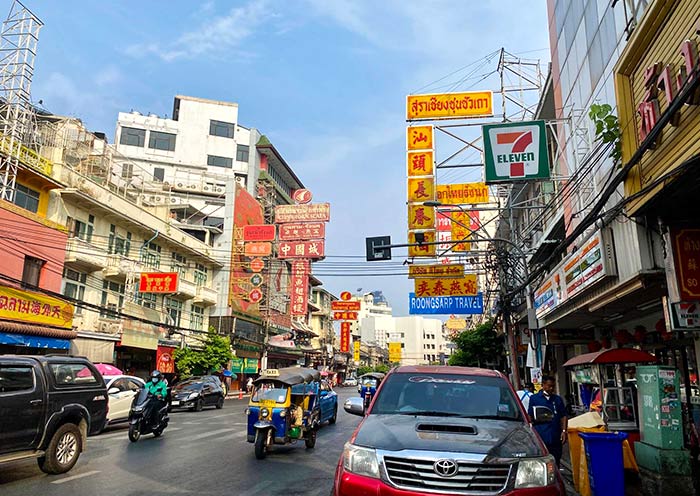
In this morning, depart from Bangkok to Pattaya (a resort city located on Thailand's eastern Gulf coast, approximately 160 kilometers south of Bangkok in Bang Lamung District, Chonburi Province) - the journey takes about 2 hours. Stay overnight in Pattaya.
Pattaya offers a delightful mix of relaxation and excitement, making it a perfect destination for a 1-2 day getaway. You will explore it on your own (if you'd prefer a guided tour, just let us know). There are three highlights for Pattaya:
(1) Island Hopping: For a change of scenery, spend a day exploring the nearby islands like Koh Larn. Enjoy snorkeling, swimming, or simply relaxing on the pristine beaches.
(2) Nightlife & Shows: Immerse yourself in Pattaya's vibrant nightlife scene. Walking Street, the most popular area, boasts a wide variety of bars, clubs, and go-go shows to cater to different preferences.
(3) Unwind on the Beaches: Dedicate a day to soaking up the sun on Pattaya's beaches. While there, consider exploring the impressive Sanctuary of Truth, a wooden temple complex showcasing intricate carvings, or Wat Phra Yai, a majestic golden Buddha statue.
Enjoy One-day Island Hopping Tour to Koh Larn (Optional):
Today, make the most of your full day in Pattaya by exploring Koh Larn! Your island adventure begins with a scenic 0.5-hour speed boat ride from Baili Hai Pier in Pattaya to Tawaen Beach, the picturesque haven of Koh Larn. Here, you can choose to relax on the beach or take watersports - tailor your activities to your interests and create a truly memorable day on Koh Larn!
Beach Bliss on Koh Larn:
- Samae Beach: The island's longest stretch of sand, perfect for water sports enthusiasts with options like jet skiing, parasailing, and banana boat rides.
- Nual Beach: Escape the crowds and find tranquility on this smaller, secluded beach offering a laid-back atmosphere.
Dive into Adventure on Koh Larn:
- Snorkeling & Diving: Discover a vibrant underwater world teeming with colorful fish and coral reefs.
- Watersports: Get your adrenaline pumping with motorboat, jet skiing, parasailing, banana boat rides, water slide, or kayaking.
After your relaxing boat ride back to Pattaya, consider exploring the vibrant nightlife scene. Walking Street, a pedestrian-only area, is packed with bars, nightclubs, and go-go bars.
For a fun and unique cultural experience, we recommend enjoying a Cabaret Show. These shows feature elaborate costumes, music, and dance performances by talented transgender performers. The Alcazar Cabaret Show is a Pattaya institution and the longest-running and most famous show in the city. With stunning costumes, elaborate sets, and high-energy performances, it's a guaranteed crowd-pleaser. (Note: Show Timings: 17:00, 18:30, 20:00 & 21:30 hrs. Be sure to book your tickets in advance, especially during peak season.)
Later in the evening, you can head to one of Pattaya's many Muay Thai gyms or stadiums, like the famous Max Muay Thai Stadium, to witness professional Muay Thai fights held every night of the week.

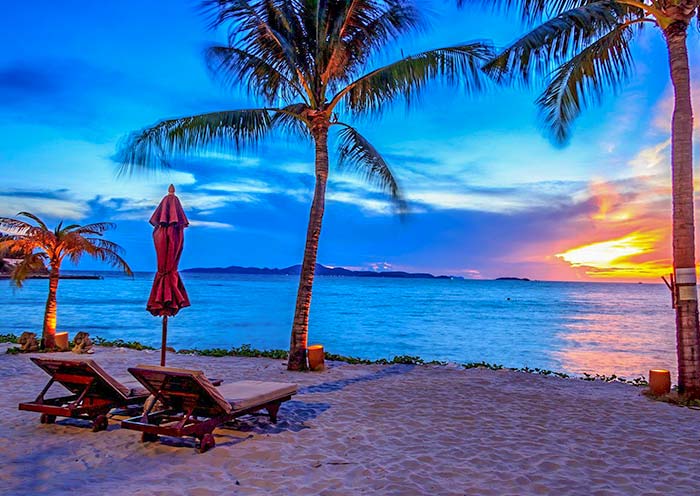

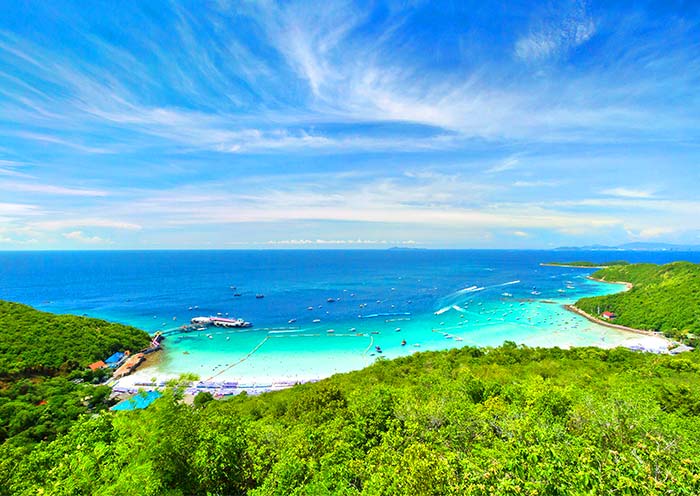
After breakfast, enjoy some free time exploring Pattaya at your own pace. (If you'd prefer a guided tour, just let us know!)
Free Time Ideas for One-day Exploration:
Kick off your day with a visit to the Sanctuary of Truth Museum, a must-see attraction in Pattaya. This massive wooden structure features intricate carvings and sculptures that depict stories from Thai mythology and Buddhist teachings.
Next, prepare for a mind-bending experience at Ripley's Believe It or Not! This museum overflows with oddities, curiosities, and unbelievable exhibits from around the world. It's a fun and quirky place for visitors of all ages.
Afterwards, enjoy a short walk to Wat Phra Yai, the iconic golden Buddha statue. Climb the stairs to the temple's peak and enjoy panoramic views of Pattaya and the surrounding area.
In the afternoon, explore the lively Pattaya Floating Market, also known as the Four Regions Floating Market. This unique market blends shopping, cultural experiences, and a chance to indulge in a variety of delicious Thai street food and local delicacies. From classic pad thai and sweet mango sticky rice to fresh seafood dishes, there's something to tantalize every taste bud. After exploring the market, treat yourself to a relaxing Thai massage offered by some vendors.
Other Adventures: If you're seeking more fun, Dongba Paradise and Qizhen Fanshan offer exciting options to consider.
After the tour, you will be transferred back to Bangkok for accommodation.

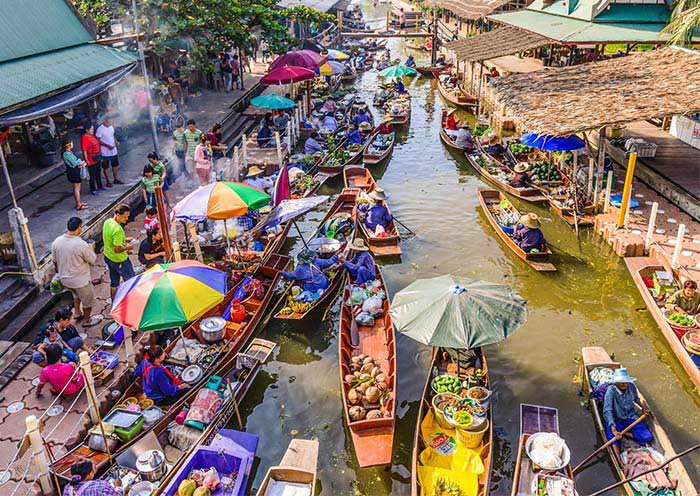
Welcome to Siem Reap, your gateway for the Temples of Angkor. When you arrive at Siem Reap–Angkor International Airport (SAI), your tour guide and driver will meet you at the exit and then escort you to the hotel in downtown Siem Reap.
Siem Reap is a city in northwestern Cambodia, best known as the gateway to the Temples of Angkor, including the iconic Angkor Wat, which is just 6 kilometers away. The city has transformed into a major tourist hub, with a diverse range of accommodations, and bustling nightlife with numerous restaurants, bars, and night markets.
Free Time Idea: Khmer traditional dance performance, featuring elegant movements and vibrant costumes set to melodious traditional music.

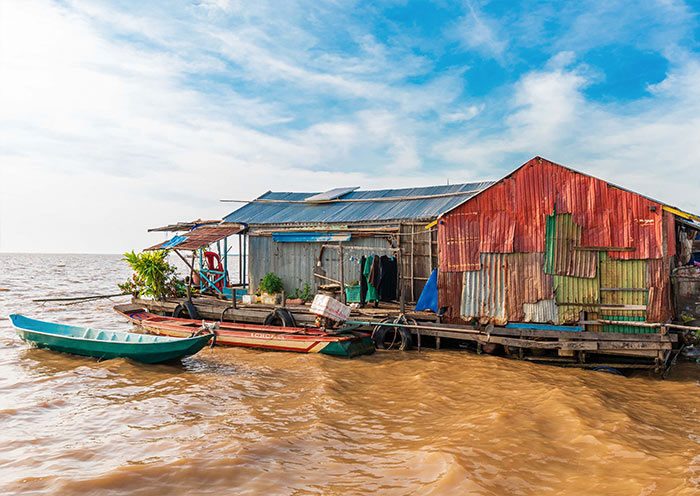
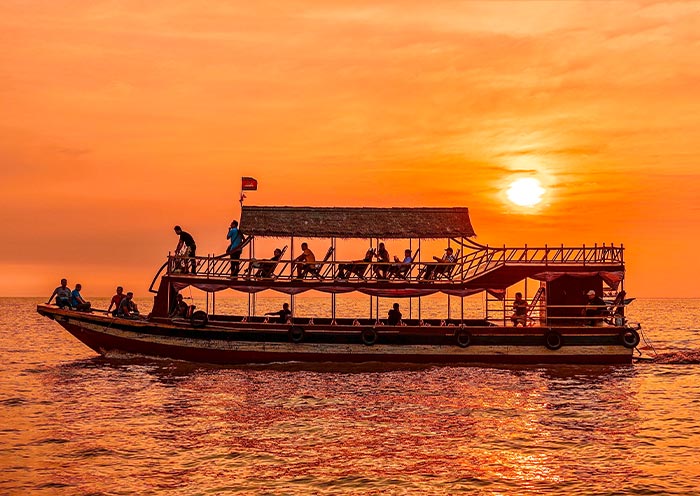
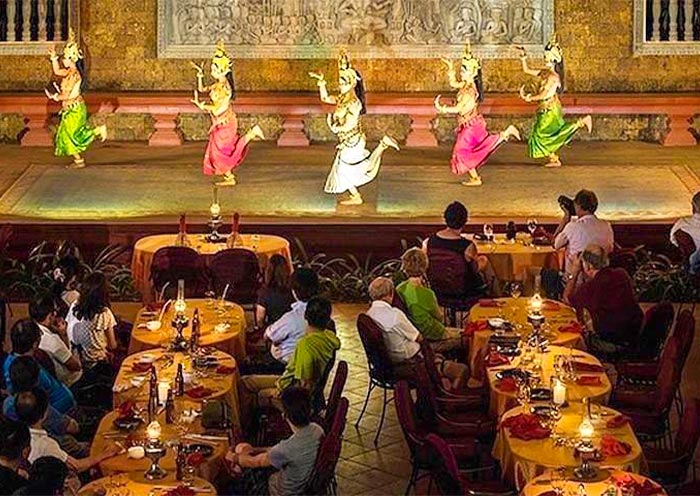
Designated as a UNESCO World Heritage site, Angkor Archaeological Park is a vast and impressive complex. It spans an area of roughly 400 square kilometers and contains the magnificent remains of the various capitals of the Khmer Empire, which flourished from the 9th to the 15th centuries.
Today, we will guide you through an exploration of some of the most iconic temples and structures within the park, including the majestic Angkor Wat and Angkor Thom complexes, and the enchanting Ta Prohm.
Scenic Spots You will Pass:
Sunrise → Angkor Thom → Ta Prohm → Angkor Wat → Phnom Bakheng Sunset → Get back to your Hotel
Start your day early with a sunrise viewing at Angkor Wat. Arrive at Angkor Wat in time to find a good spot to watch the sunrise. Tips: The sun rises between 5:30 AM and 6:30 AM, depending on the time of year. The silhouette of Angkor Wat’s iconic spires stands sharply against the lightening backdrop, creating a stunning contrast that slowly fills with color. The temple's vast moat reflects this magical scene, doubling the beauty in a perfect mirror image that enhances the surreal atmosphere. After the sunrise, head back to your hotel for breakfast and a short rest.
After breakfast, head to Angkor Thom, the last and most enduring capital city of the Khmer empire. It was established in the late 12th century by King Jayavarman VII in the late twelfth century. Angkor Thom means "Great City" in Khmer. Set over 10 square kilometers, the aptly named last great capital of the Khmer empire took monumental to a whole new level.
Enter through the South Gate and proceed to the Bayon Temple at the city's center. This temple is known for its numerous smiling faces carved into its towers. Each of its 54 Gothic towers is decorated with 216 gargantuan smiling faces of Avalokiteshvara. The temple also features 1.2km of extraordinary bas-reliefs, incorporating more than 11,000 figures. Take your time to marvel at these detailed bas-reliefs, which portray historical events and scenes from daily life in the empire. A short walk northwest from the Bayon will bring you to the Baphuon Temple. This temple, which predates Angkor Thom, was originally a Hindu temple dedicated to Shiva.
Next, visit the Terrace of the Elephants. King Jayavarman VII used this terrace as a viewing platform to observe his victorious returning army. You'll find it adorned with carvings of elephants and other animals, providing excellent photo opportunities. Continue to the nearby Terrace of the Leper King. This 7-meter high laterite platform features multiple tiers of meticulously carved walls depicting nagas (serpents), demons, and various mythical beings. Conclude your visit to Angkor Thom by exiting through the Victory Gate on the east side of the city.
Later, proceed to Ta Prohm (Jungle Temple). Its appeal lies in the fact that, unlike the other monuments of Angkor, it has been swallowed by the jungle, and looks very much the way most of the monuments of Angkor appeared when European explorers first stumbled upon them. It was also featured in the movies "Tomb Raider" and “Raiders of the Lost Ark”, which adds to its popularity. After exploring Ta Prohm, enjoy a relaxing lunch at one of the local restaurants nearby.
In the afternoon, return to Angkor Wat for a more detailed tour of this iconic temple. Uniquely designed with a westward orientation, Angkor Wat is best viewed in the afternoon light. Angkor Wat, the largest monument of the Angkor group and the best preserved, is an architectural masterpiece. Its perfection in composition, balance, proportions, relief, and sculpture make it one of the finest monuments in the world.
Angkor Wat is surrounded by a vast moat, 190 meters wide, forming a rectangle of 1.5 by 1.3 kilometers, which symbolizes the mythical oceans surrounding Mount Meru, the center of the universe in Hindu cosmology. Visitors can enter through the west-facing main gate, which leads directly into a long causeway lined with naga balustrades. Spend time in the galleries which feature extensive bas-reliefs depicting epic stories such as the Battle of Kurukshetra from the Mahabharata, the Judgment by Yama, the Hindu god of death, and scenes of heavenly nymphs (Apsaras) and everyday life in the Khmer Empire. At the heart of the temple complex is the central sanctuary surrounded by four smaller towers, forming a quincunx. The central sanctuary, rising majestically above the forested landscape, symbolizes the mythical Mount Meru and offers a unique perspective on the temple’s layout and the geometric precision with which it was built. Climb up to the central tower, a privilege that offers not only a closer view of the intricate lintel carvings and sculpted friezes but also panoramic views of the entire complex and its surroundings.
If you have enough energy, consider climbing up to Phnom Bakheng Hill to enjoy the sunset view. The climb takes about 15-20 minutes. Arrive early as this popular spot can get crowded at sunset. From here, watch the sky change colors over the main temples of Angkor and the surrounding forests - a perfect end to a day of exploration.
After the tour, drive back to your hotel. Stay overnight in Siem Reap.
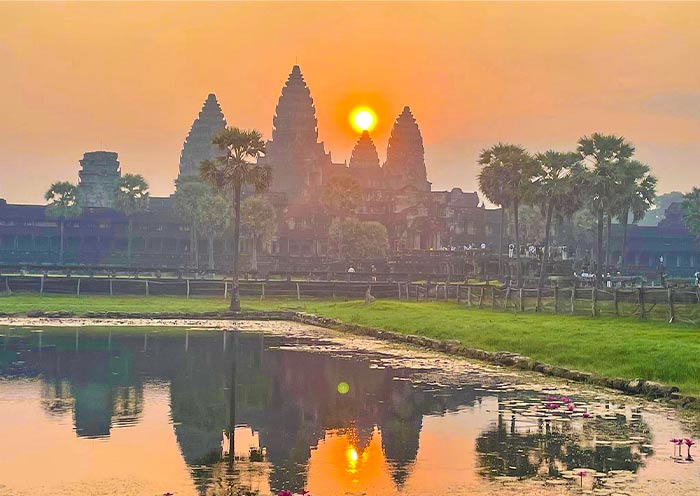


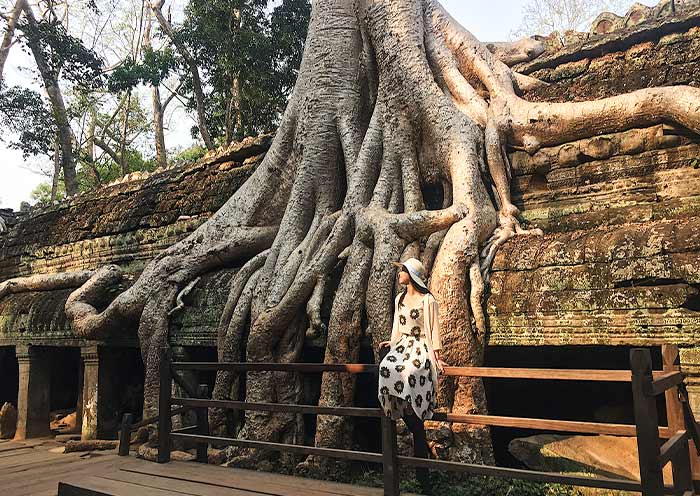
Welcome to Ho Chi Minh City! Formerly known as Saigon, Ho Chi Minh City is the largest city in Vietnam. Located in southern Vietnam, it's a well-blended mix of historical significance and modern dynamism.
Upon arrival at Tan Son Nhat International Airport in Ho Chi Minh City (approximately 6.5km from downtown), your local guide will meet you and escort you to your hotel. The rest of today is free for you to explore the city on your own.
Free Time Idea:
Immerse yourself in Saigon's famed coffee culture at the Coffee Apartment, then be captivated by the vibrant atmosphere of Ben Thanh Market. Explore a world of local crafts, and tantalize your taste buds with the incredible array of Vietnamese street food - a sensory explosion you won't forget!
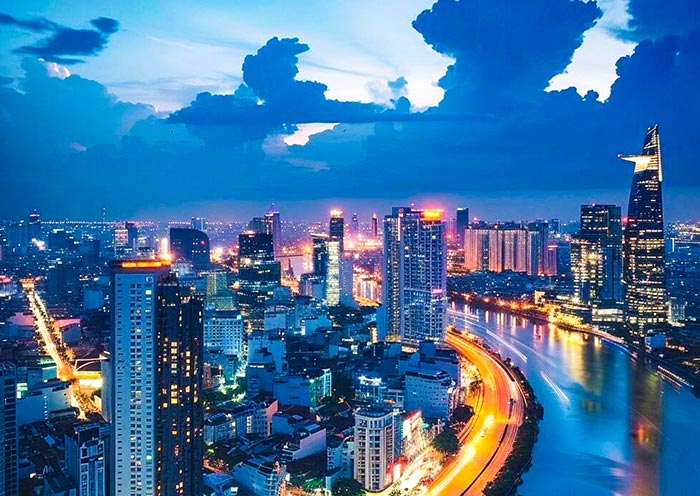

After breakfast, after a comfortable 1.5-hour drive, you will arrive at the Cu Chi Tunnels. Here, you and your family will have the opportunity to explore the intricate tunnel system, which consists of narrow passageways, hidden entrances, and underground chambers. Your guide will share insights into the daily life of the Cu Chi guerrilla fighters and their remarkable ability to survive within the tunnels. Prepare to crawl through sections of the tunnels that were used during the Vietnam War. You will see firsthand the kitchens, living quarters, and other essential spaces built underground. Additionally, you will visit weapon rooms and discover how these resourceful soldiers crafted their tools.
After the tour, return to Ho Chi Minh City for a half-day city tour to explore Ho Chi Minh City's rich history, culture, and vibrant modern life.
Our first stop is the Reunification Palace, also called the Independence Palace, a captivating architectural marvel that once served as the residence of the South Vietnamese President. Here, you can witness the iconic image of North Vietnamese tanks storming the palace gates, a defining moment that marked the end of the Vietnam War in 1975. Next, we head to the War Remnants Museum, a poignant and powerful testament to the realities of the Vietnam War. Prepare to be moved by exhibits showcasing artifacts, photographs, and weaponry that tell stories of war and resilience.
Next on your itinerary is Nha Tho Tan Dinh, also known as the Pink Church. This vibrant landmark stands out with its unique hue, making it instantly recognizable and a popular spot to capture stunning photos. Step back in time as you learn that Nha Tho Tan Dinh was built in the late 19th century, making it one of the oldest churches in Ho Chi Minh City. Admire the fascinating blend of Romanesque and Gothic styles in its architecture, with two grand bell towers flanking the entrance. Snap some cool pictures outside to remember your visit!
Afterwards, head to the Jade Emperor Pagoda, a vibrant temple dedicated to the supreme deity in Taoism, the Jade Emperor. Here, you can marvel at colorful statues, intricate carvings, and exquisite woodwork that adorn the pagoda. Then, be transported back in time at the Central Post Office, a majestic building constructed in the early 20th century. Take a moment to appreciate the impressive facade with its wrought-iron details and colorful mosaic floors. (Optional Experience: To create a lasting memory of Vietnam, send postcards to your loved ones from this historic landmark.)
Stay overnight in Ho Chi Minh City.
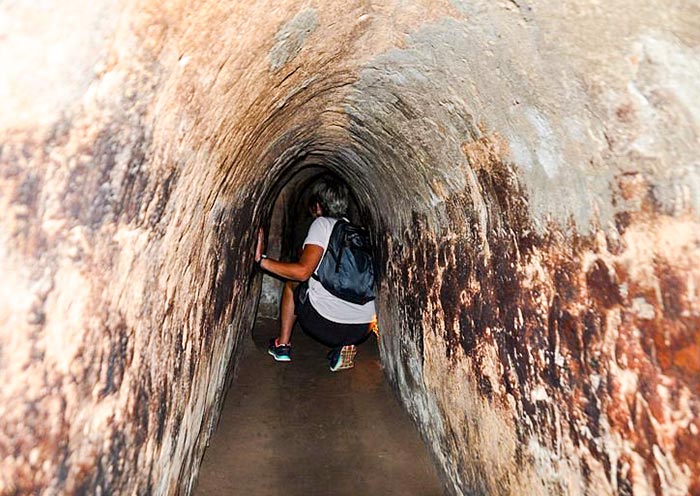



After breakfast, spend a full day exploring the Mekong Delta at a relaxing pace. Mekong Delta, located in southwestern Vietnam, is a vast maze of rivers, canals, islands, and rice paddies formed by the Mekong River as it empties into the sea. Known as the "rice bowl" of Vietnam, the Delta is a major agricultural hub, producing a significant portion of the country's rice and fish.
Start from Ho Chi Minh City, you and your family will pass through green rice fields and small villages to arrive in beautiful rural My Tho. Upon arrival, your first stop is Vinh Trang Pagoda. Built in the mid-19th century, Vinh Trang is renowned for its stunning architecture, showcasing a harmonious fusion of Vietnamese, Chinese, and Khmer influences. You will be amazed by the outstanding architecture, meticulously carved columns with intricate details, and visits to the Statue of Maitreya Buddha, Statue of Amitabha Buddha, Reclining Buddha statue, and 7-story tower.
Later, head to the nearby pier to board a traditional Mekong Delta boat for a scenic cruise along the majestic river. As you explore, lush greenery and bustling river life will captivate you. Glide past the Turtle, Dragon, and Phoenix Islets, eventually arriving at the enchanting Unicorn Islet. And, delve deeper into the Delta's heart with a ride on a traditional sampan boat through narrow waterways lined with coconut palms. This intimate experience allows you to appreciate the unique ecosystem and the local way of life firsthand. You and your family will stop at a bee farm to savor honey tea, taste local fruits, and immerse yourself in traditional music performed by the villagers. Learn about their daily lives and gain a deeper understanding of the region's culture. Enjoy a local lunch with Vietnamese dishes.
After lunch, take a boat trip to Ben Tre, known as the coconut kingdom, a charming town famous for its coconut plantations and fruit orchards. Enjoy a leisurely bike ride through the countryside and learn about how coconut products are produced in the region. Visit a coconut candy workshop.
After the memorable tour, get back to Ho Chi Minh City.

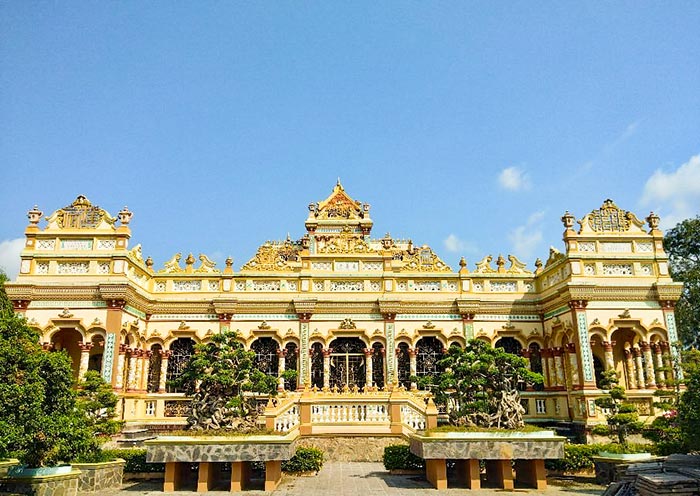


This morning, you'll be transferred from Ho Chi Minh to Hanoi by flight. Welcome to Hanoi, the capital city of Vietnam!
Hanoi, located in northern Vietnam, boasts a rich history dating back over 1,000 years. It showcases a blend of Vietnamese, Chinese, and French influences. Renowned for its diverse culinary scene, Hanoi is considered a food lover's paradise to taste Vietnamese cuisine. The city is famous for its street food, where you can savor an array of local specialties.
Upon arrival at Noi Bai International Airport, you will be met by our local guide and driver. Then, we will take you to your carefully selected hotel in Hanoi. We will assist you with check-in. The rest of today is free for you to explore this old and charming city at your own pace.

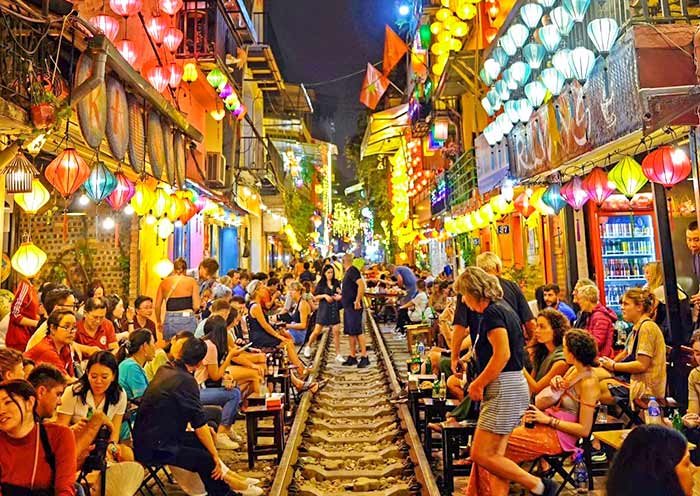
After breakfast, your guide will pick you up at your hotel for a delightful day exploring Hanoi City. This city holds a unique charm despite not being the most modern. Its character lies in the captivating blend of Vietnamese, Chinese, and French influences, all woven together with the city's authentic and bustling local life within its old alleyways. Indulge in the delicious local street food for a taste of true Vietnamese flavors.
Our first stop is a tranquil escape to Tran Quoc Pagoda, nestled amidst the picturesque West Lake. It is the oldest Buddhist temple in Hanoi, with a history dating back over 1500 years. As you approach, you'll be greeted by the sight of the iconic 11-story lotus tower, a symbol of the pagoda. Step inside the main hall and explore its beauty, where intricate carvings and frescoes adorn the walls. Be sure to admire the serene lotus pond, adding to the pagoda's peaceful atmosphere.
Later, head to the Ho Chi Minh Mausoleum, situated in Ba Dinh Square. The mausoleum serves as the final resting place of Ho Chi Minh (Uncle Ho), the revered leader of Vietnamese independence and the founding father of modern Vietnam. Dress respectfully and visit the mausoleum to pay homage to this iconic figure and learn about his immense role in shaping the nation. If you're lucky, you might witness the solemn and precise military honor guard ceremony. (Note: 1. The Mausoleum closes from Sep. 4 to Nov. 4 every year. 2. The surrounding sites include the Presidential Palace, Ho Chi Minh's Stilt House, and the Ho Chi Minh Museum.)
Afterward, enjoy a short walk to visit the One Pillar Pagoda. Prepare to be amazed by its distinctive shape: the main building sits atop a single stone pillar, resembling a lotus flower blossoming from a pond. Legend has it that Emperor Ly Thai Tong dreamt of receiving a son from the Buddhist goddess of mercy, Quan Am Bo Tat, on a lotus flower. The pagoda's construction served as a way to express his gratitude. Later, visit the Temple of Literature, Vietnam's first university and a site dedicated to Confucianism. (Optional: you can make a quick stop at the famous Hanoi Train Street for photos, if you'd like.)
This afternoon, delve into Vietnam's fascinating history at the Vietnam National Museum of History. Here, you'll gain a comprehensive understanding of Vietnam's past, from prehistoric times to the 20th century, through a captivating display of artifacts. Witness ancient bronze drums, intricate ceramics, and powerful imperial regalia, each piece whispering stories of Vietnam's remarkable evolution.
Later, head to Hoan Kiem Lake, also known as Lake of the Restored Sword, a shimmering jewel in the heart of Hanoi. Take a leisurely stroll along the lake's perimeter, enjoying a view of the iconic Turtle Tower. Legend tells the tale of Emperor Le Loi returning a magical sword to a giant turtle residing in the lake, thus giving rise to the name "Lake of the Returned Sword." Afterwards, visit Ngoc Son Temple, dedicated to various Vietnamese historical figures and the revered Confucian scholar Van Xuong.
Afterward, immerse yourself in the local life of Vietnam with a unique and fun cyclo tour! For about an hour, you'll travel at a slow and leisurely pace through the iconic Old Quarter of Hanoi. A cyclo, a traditional three-wheeled bicycle taxi, will be your chariot for exploring the narrow streets. Cruise through the famed 36 Streets (each named after a specific trade) and pass by iconic landmarks like Dong Xuan Market, St. Joseph's Cathedral, and the Hanoi Opera House. This is a fantastic way to experience the Old Quarter's charming and vibrant atmosphere firsthand! Don't miss the chance to savor the delicious variety of Vietnamese street food and local dishes!
Optional Water Puppet Show: Immerse yourself in a unique Vietnamese tradition by catching a water puppet show in the late afternoon or evening! Dating back to the 11th century, these captivating performances use colorful puppets manipulated on a water stage to depict folktales and historical events. A highly-recommended venue for this experience is the Thang Long Water Puppet Theatre.
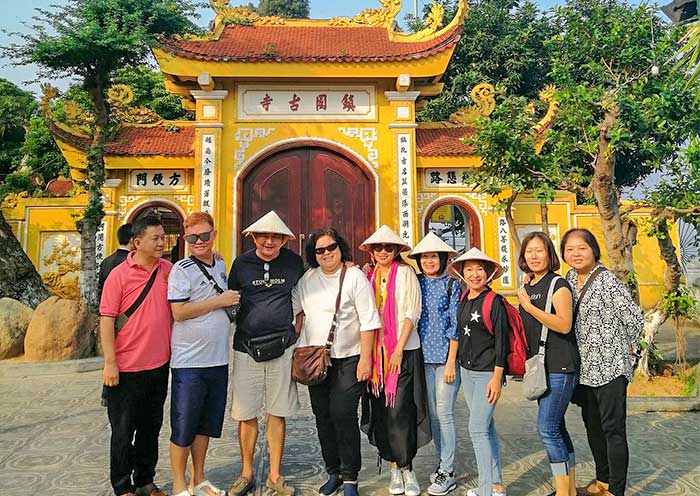


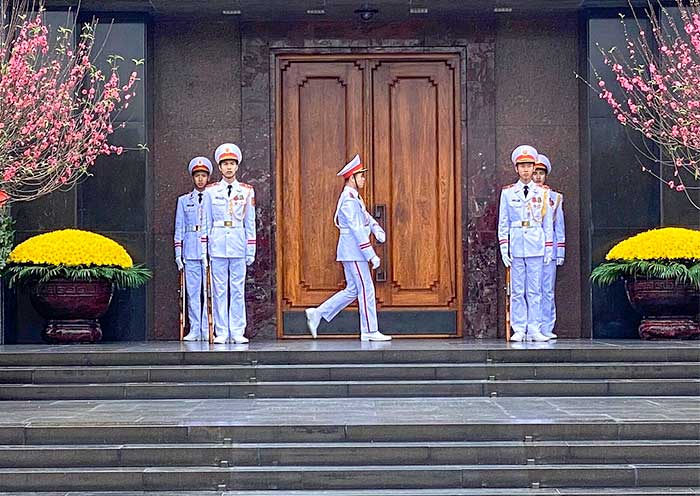
Halong Bay, A UNESCO World Heritage Site, boasts thousands of majestic limestone formations, sculpted by nature over millions of years. Reputed as “Guilin on the Sea”, these emerald islands rise dramatically from crystal-clear turquoise waters, creating a breathtaking seascape. Thanks to its dramatic cliffs, shimmering turquoise waters, and over 1,600 limestone islands and islets, Halong Bay is one of the most popular destinations in northern Vietnam. A cruise offers the best way to experience its unparalleled beauty.
Morning:
This morning, between 8:00 AM and 8:30 AM, the cruise company's shuttle bus will pick you up in Hanoi's Old Quarter area. Hop aboard and prepare to be whisked away on a scenic 2.5-hour drive (147 km) to stunning Halong Bay!
Upon arrival, you'll be warmly welcomed aboard with a refreshing drink. Following a quick safety briefing from the cruise manager, you can relax and savor a delicious lunch onboard.
Afternoon:
This afternoon, you’ll explore Halong Bay's dramatic karst landscape with your cruise! Different cruise companies offer various itineraries, but you might visit some of these fascinating spots and try water activities like kayaking, swimming, etc. Watch the sunset paint the karst mountains with colors.
- Sung Sot Cave (Surprise Cave): Discover a magnificent cave adorned with stalactites and stalagmites.
- Titop Island: Hike to the peak for breathtaking panoramic views of the bay.
- Cua Van Fishing Village: Witness the traditional way of life of local fishermen in a floating village.
- Tung Sau Pearl Farm: Learn about pearl cultivation and see these beautiful gems firsthand.
- Trinh Nu Cave (Virgin Cave): Discover a secluded cave with a unique rock formation.
Evening
This evening, indulge in a hearty dinner prepared by our talented chefs in the elegant dining room. After dinner, unwind with a variety of leisure options: join in on board games, try your hand at squid fishing, catch a night movie, or head to the bars & karaoke. Overnight onboard.
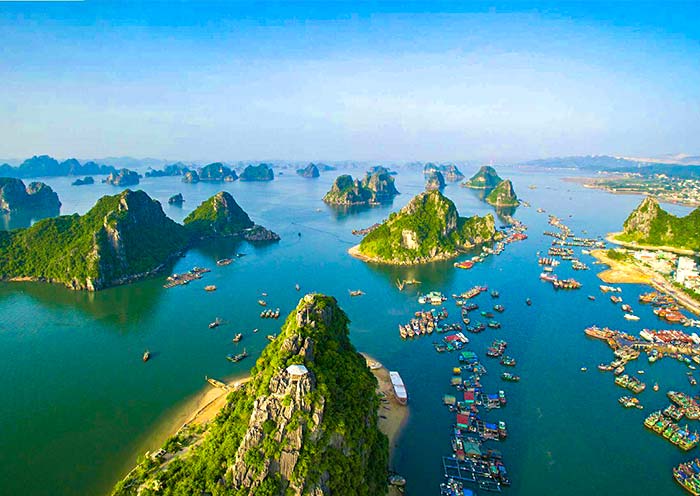
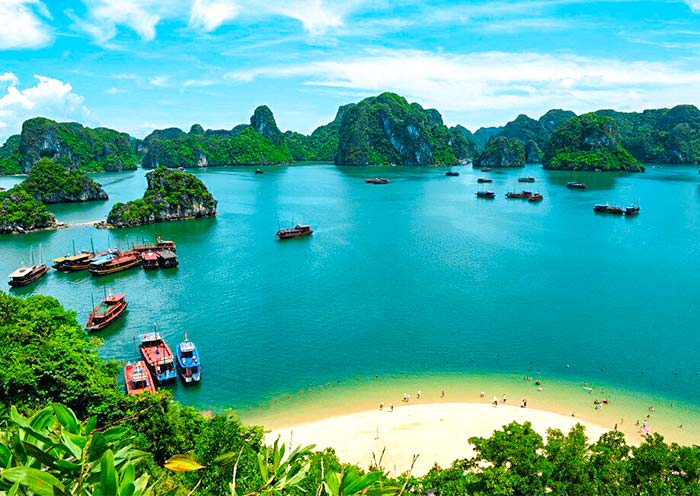
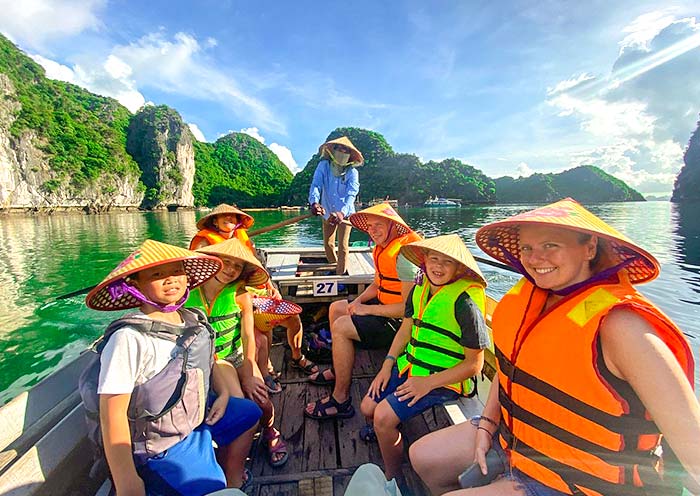
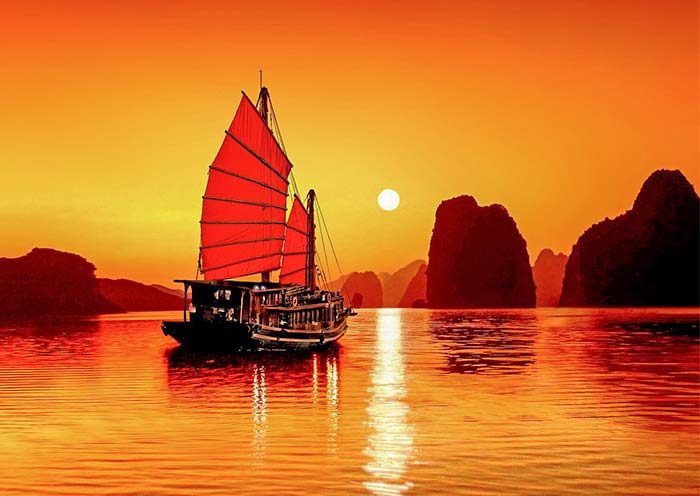
Early risers can embrace the sunrise with a Tai Chi class on the sundeck, invigorating your body and mind. Enjoy a delicious breakfast to onboard.
After breakfast, continue your exploration of Halong Bay! You can choose to participate in exciting water activities like kayaking or follow the cruise itinerary to admire the majestic limestone formations.
Later this morning, return to the cruise for a smooth check-out process at the reception. As you cruise back to the pier, savor a delightful lunch at 10:00 AM. Disembarkation will take place between 11:00 AM and 11:30 AM.
Following disembarkation, you'll be transferred back to Hanoi. Free time in Hanoi.
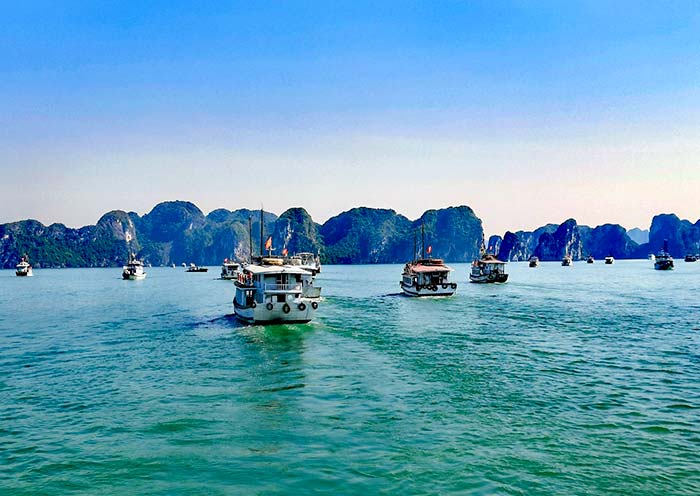

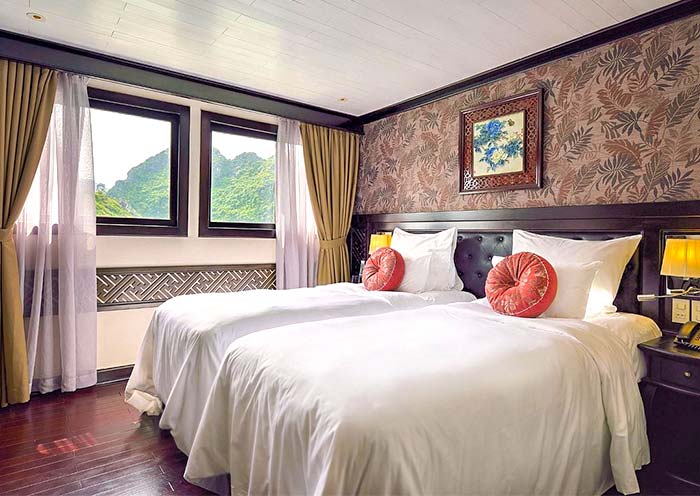
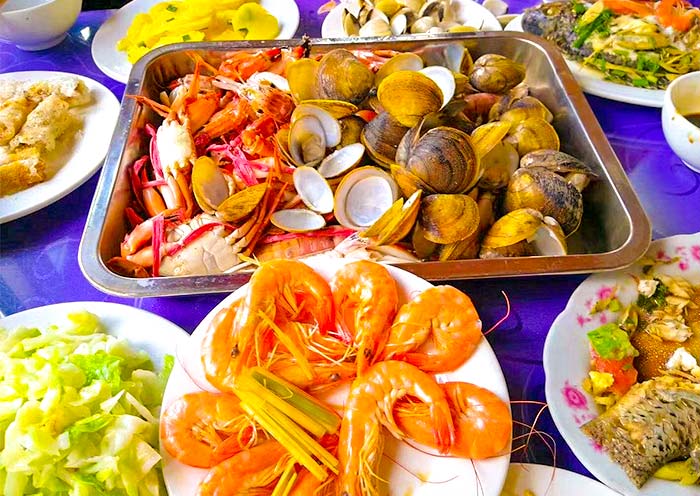
It is time to end your 14-day Thailand Cambodia Vietnam Tour. You will have some free time in Hanoi and explore more on your own till your guide or driver escorts you to the airport for your flight to your next destination.
Extension Ideas:
If you plan to continue exploring neighboring countries in Southeast Asia or Asia, such as Laos, India, or China, don't hesitate to let us know. We can customize your itinerary and assist with travel arrangements.
Thank you for choosing Asia Odyssey Travel (AOT) for your Asia tour, and we are always here working for you and hope to see you again for your next trip to Asia. Safe journey!
Price: What’s Included & What’s Excluded
What's Included:
What's Excluded:
Important Travel Tips for Visiting Japan
Get the right visa. Depending on your nationality and the length of your stay, you may need to apply for a visa in advance. You can do this online or at a Japanese embassy or consulate. Many countries are part of Japan’s visa exemption program, allowing their citizens to enter Japan for short stays without a visa for tourism. Always check if your country is on this list before applying for a visa. If you have any questions, feel free to contact our travel experts for more information.
The best time to visit Japan depends on your interests:
Spring (March to May): Ideal
for witnessing the cherry blossoms and enjoying mild weather. Major cities like Tokyo, Kyoto, and Hiroshima
are particularly beautiful as cherry trees bloom spectacularly.
Summer (June to
August): Perfect for experiencing vibrant festivals such as Gion Matsuri in Kyoto,
Tanabata Matsuri across the country, and enjoying the natural beauty of Hokkaido, which is less humid than
the rest of Japan. Note that early summer (June) is the rainy season.
Autumn (September to
November): Offers stunning fall foliage, making it a great time for hiking and temple
visits. The weather is cool and pleasant, ideal for outdoor activities.
Winter (December to
February): The best time for winter sports, especially in regions like Hokkaido and the
Japanese Alps. Onsens (hot springs) are also a popular attraction during the cold months.
Bring Cash. Despite advances in digital payment, many smaller vendors, temples, and rural
areas operate predominantly with cash. It’s wise to keep some yen on hand at all
times.
Universal Travel Adapter. Japan uses 100V with two straight thin
pins.
Passport: Ensure it’s valid for at least six months beyond your date
of travel.
Visa (if required): Make sure you have the right visa for your
travel.
Travel Insurance Information: Always good to have on hand.
Bow when greeting: A slight bow is a common way to say hello, thank you, or
sorry.
Be mindful of your noise level: Japanese culture values quietness,
especially in public transportation and residential areas.
Follow the rules: Whether
it's waiting in line or adhering to signage, following local rules and etiquette is highly
valued.
Etiquette in temples and shrines: Wear modest clothing and follow specific
customs such as washing hands and mouth before entering a shrine or temple. Photography might be restricted
in sacred areas.
Looking for more travel guides for first-time visitors to Japan? Want to gather additional information to plan your trip? Our team of professional travel experts has written over 40 articles about Vietnam. Please check out ourJapan Travel Guide for inspiration and detailed insights.
Hotel Conditions for Your Japan Tour
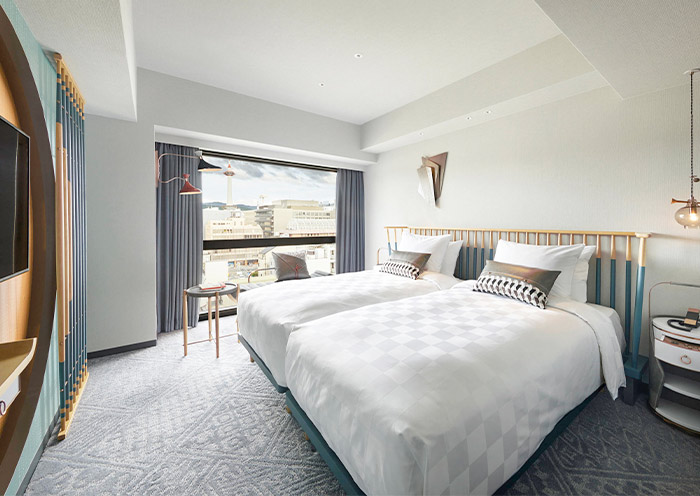

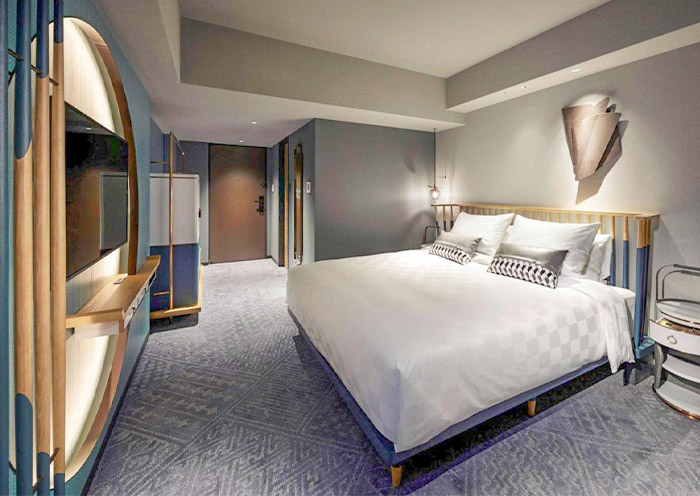

We offer a range of accommodation options to suit various preferences and budgets: luxurious 5-star hotels, comfortable 4-star hotels, and economical 3-star hotels. Our selected hotels are conveniently located close to the city center or popular tourist spots.
For those seeking a more distinctive lodging experience, we also offer Traditional Ryokans, Machiya, Onsen (hot springs) Hotels, etc. If you have specific needs or preferences, please consult with your travel advisor.
Tips: Be aware that hotel room sizes in Japan may be smaller compared to those in other developed countries due to the scarcity of land. If your budget allows, it is recommended to opt for a higher category of hotel, which will generally offer more comfort.
Photo Gallery for This Itinerary
Latest Japan Tours Reviews from Our Customers

Sam Lin
Singapore
Date of Experience: Dec 24, 2024
Tour Customized by: Vincent
You May be Interested in This Tour: 8 Days Best Japan Group Tour: Japan Highlights & Hiroshima

Zhang Xin Hua
Malaysia
Visiting Japan’s Golden Route in October was incredible! From Tokyo's vibrant city life to the serene beauty of Mount Fuji, every stop was unforgettable. Kyoto’s temples and Nara’s friendly deer captured Japan’s charm, while Osaka’s food scene was a delight. The mix of tradition and modernity made it a perfect 7-day journey!
Date of Experience: Oct 26, 2024
Tour Customized by: Allan
You May be Interested in This Tour: 7 Days Japan Golden Route Tour in Small Group

Dan Z
Washington DC
Date of Experience: Aug 24, 2024
Tour Customized by: Rex
You May be Interested in This Tour: 7 Days Japan Kansai Tour with Hiroshima: Osaka, Kyoto, Uji & Nara
Price: Request
(Based on a private tour for two people. Price varies depending on program, travel date, number of people.)
Free Enquiry! You don’t need to pay for the reservation.
- United States (+1)
- Australia (+61)
- Singapore (+65)
- Malaysia (+60)
- Philippines (+63)
- Canada (+1)
- Italy (+39)
- Indonesia (+62)
- United Kingdom (+44)
- Spain (+34)
- Mexico (+52)
- Hong Kong (+852)
- Thailand (+66)
- United Arab Emirates (+971)
- New Zealand (+64)
- South Africa (+27)
- Germany (+49)
- Brazil (+55)
- India (+91)
- France (+33)
- Vietnam (+84)
- The Netherlands (+31)
- Saudi Arabia (+966)
- Ireland (+353)
- Argentina (+54)
- Switzerland (+41)
- Romania (+40)
- Pakistan (+92)
- Japan (+81)
- Portugal (+351)
- Bangladesh (+880)
- South Korea (+82)
- Puerto Rico (+1)
- Türkiye (+90)
- China (+86)
- Belgium (+32)
- Qatar (+974)
- Greece (+30)
- Taiwan (+886)
- Austria (+43)
- Poland (+48)
- Israel (+972)
- Chile (+56)
- Sri Lanka (+94)
- Nigeria (+234)
- Peru (+51)
- Colombia (+57)
- Hungary (+36)
- Nepal (+977)
- Denmark (+45)
- Bulgaria (+359)
- Norway (+47)
- Slovenia (+383)
- Sweden (+46)
- Kuwait (+965)
- Costa Rica (+506)
- Ecuador (+593)
- Venezuela (+58)
- Malta (+356)
- Croatia (+385)
- Tunisia (+216)
- Czechia (+420)
- Mongolia (+976)
- Bahrain (+973)
- Mauritius (+230)
- Papua New Guinea (+675)
- Cambodia (+855)
- Dominican Republic (+1)
- Luxembourg (+352)
- Finland (+358)
- Guatemala (+502)
- Myanmar (+95)
- Maldives (+960)
- Slovakia (+421)
- Laos (+856)
- Serbia (+381)
- Brunei (+673)
- Oman (+968)
- Macao (+853)
- Panama (+507)
- Morocco (+212)
- Jordan (+962)
- Georgia (+995)
- Fiji (+679)
- Bolivia (+591)
- Lithuania (+370)
- Bahamas (+1)
- Cyprus (+357)
- Latvia (+371)
- Bhutan (+975)
- Iraq (+964)
- Iran (+98)
- Kenya (+254)
- Jamaica (+1)
- Zimbabwe (+263)
- Azerbaijan (+994)
- Uruguay (+598)
- Estonia (+372)
- Andorra (+376)
- Cameroon (+237)
- Ghana (+233)
- Kazakhstan (+7)
- Nicaragua (+505)
- Egypt (+20)
- Russia (+7)
- Albania (+355)
- Réunion (+262)
- Montenegro (+382)
- Algeria (+213)
- Afghanistan (+93)
- Martinique (+596)
- Uganda (+256)
- Honduras (+504)
- North Macedonia (+389)
- Trinidad and Tobago (+1)
- Suriname (+597)
- Antigua and Barbuda (+1)
- Zambia (+260)
- Ukraine (+380)
- Armenia (+374)
- Barbados (+1)
- Belarus (+375)
- Palestine (+970)
- Lesotho (+266)
- Moldova (+373)
- Ethiopia (+251)
- French Polynesia (+689)
- Gambia (+220)
- Guam (+1)
- Gibraltar (+350)
- Isle of Man (+44)
- New Caledonia (+687)
- El Salvador (+503)
- Comoros (+269)
- Seychelles (+248)
- Chad (+235)
- Samoa (+685)
- Cook Islands (+682)
- Palau (+680)
- Paraguay (+595)
- DR Congo (+243)
- Solomon Islands (+677)


